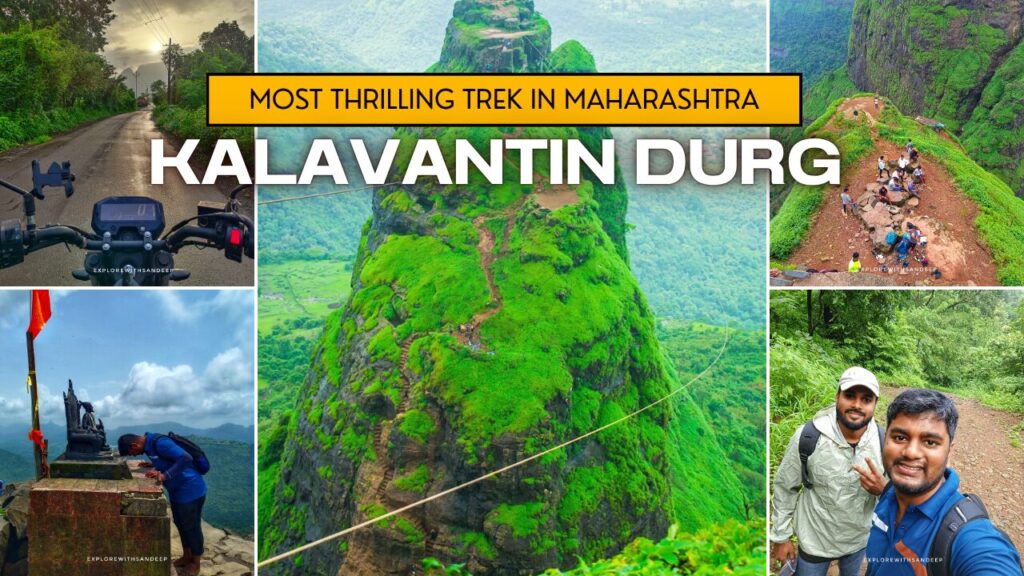Kalavantin Durg (कलावंतीण दुर्ग)
When you hear the name Kalavantin Durg, the first thing that comes to mind is its steep rock-cut steps and the adrenaline rush that attracts adventure lovers from across Maharashtra. If that’s what you imagined, you’re absolutely right! 🎯 This fort is a paradise for thrill-seekers (and a nightmare for anyone afraid of heights 😅). Located near Panvel, Mumbai, it’s even visible from the Mumbai-Pune highway – like nature’s way of saying “Come if you dare!” 😈
Kalavantin Durg stands proudly amidst the majestic Sahyadri mountain range ⛰️. Directly in front of it stands the mighty Prabalgad Fort, which carries the legacy of Chhatrapati Shivaji Maharaj 👑. At the summit of Kalavantin Durg, an idol of Shivaji Maharaj sits regally on a throne – a sight powerful enough to give you goosebumps (and make you forget how tired your legs are! 🦵💪). From the top, you can spot seven magnificent forts spread across the horizon like ancient sentinels playing hide and seek! 🏰👀
In this blog, I’ll share my personal trekking experience, provide essential trek information, and clear up some common misconceptions. So grab a cup of chai ☕ and join me on this virtual climb to Kalavantin Durg!
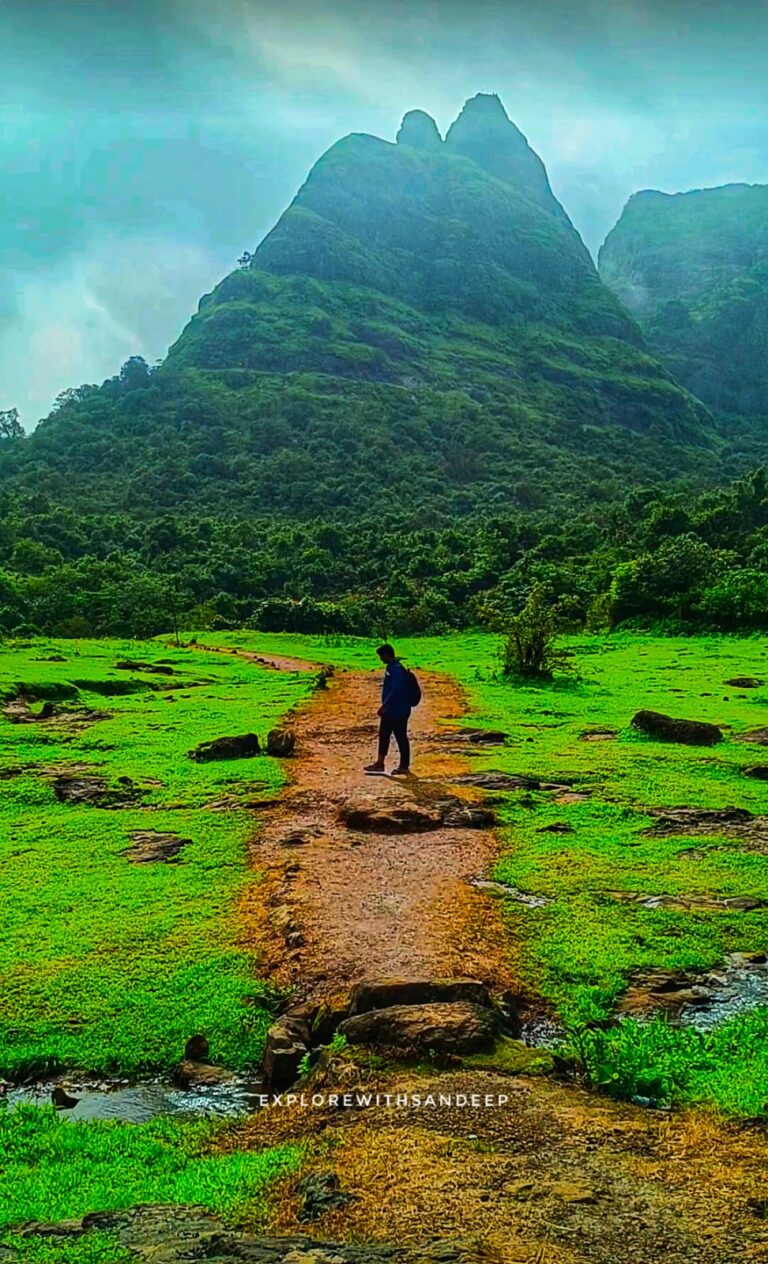
About Kalavantin Durg 📋
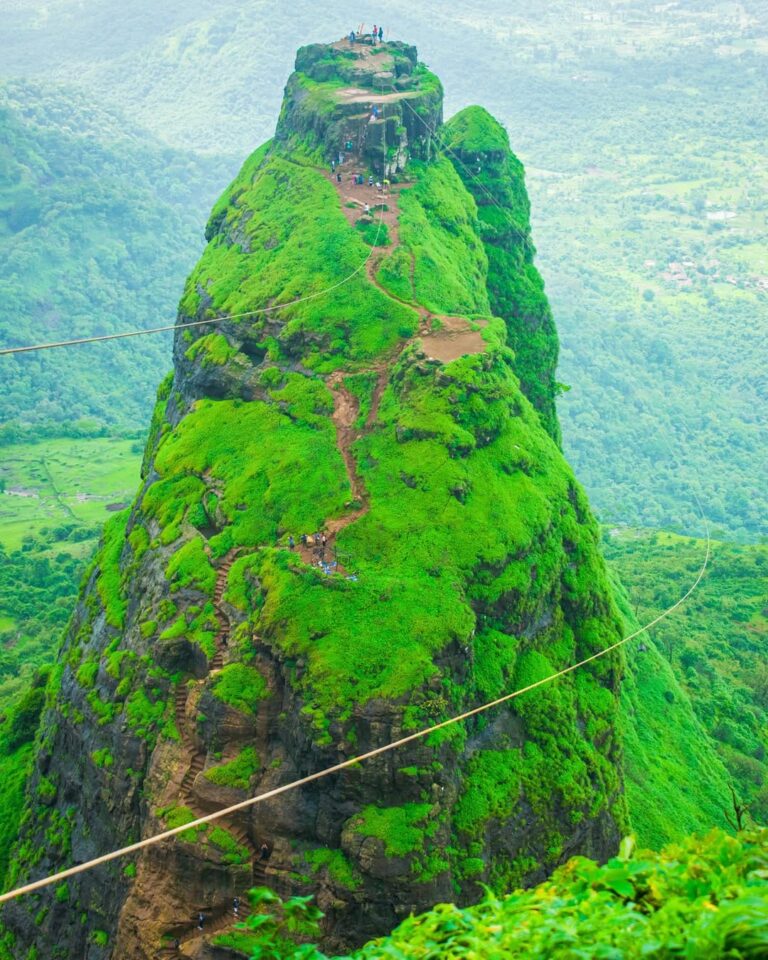
Before diving into my trek story here are the essential details about Kalavantin Durg:
Basic Information:
– Height: Approximately 2,250 feet (686 meters) above sea level 📏
– Location: Near Thakurwadi village, close to Panvel, Maharashtra 📍
– History: Believed to be built during the Maurya or Bahmani dynasty, possibly named after a queen called Kalavantin 👸
– Purpose: Served as a watchtower and lookout point rather than a traditional fort 🔭
– Famous For: Vertical rock-cut steps with no railings (because ancient people were apparently fearless! 😱) and breathtaking panoramic views 🌄
– Best Season: Winter (October to February) for safety, Monsoon (June to September) for lush greenery and extra slippery fun! 🌧️😅
– Difficulty Level: ⭐⭐⭐⭐ (4/5 – Expert level, aka “Are you sure about this?” level 🤔)
Important Warning: This trek is only for experienced trekkers. The stair climb is very risky during the monsoon as the rocks become extremely slippery! 🐧💦 In summer, it’s more manageable. Always wear proper trekking shoes and be very careful (a little prayer might help too 🙏)
The Adventure Begins 🚀
My Kalavantin Durg adventure started when my friend Mahesh visited from Vadodara specifically for trekking in Maharashtra. Now, I’m currently in Mumbai for work (not a local, just a temporary Mumbaikar trying to survive the city chaos! 🏙️😵💫), but I felt responsible for showing him something truly spectacular. Though I had never been to Kalavantin Durg myself, it had always been on my bucket list as a serious trekker (translation: I wanted to see if I could actually do it without crying 😭).
We started our journey from Bandra at 5:30 AM🌅, heading toward Panvel. Since it was monsoon season, the weather was pleasantly cool with light drizzles that made our bike ride even more enjoyable (and gave us a free pre-shower! 🚿😂).
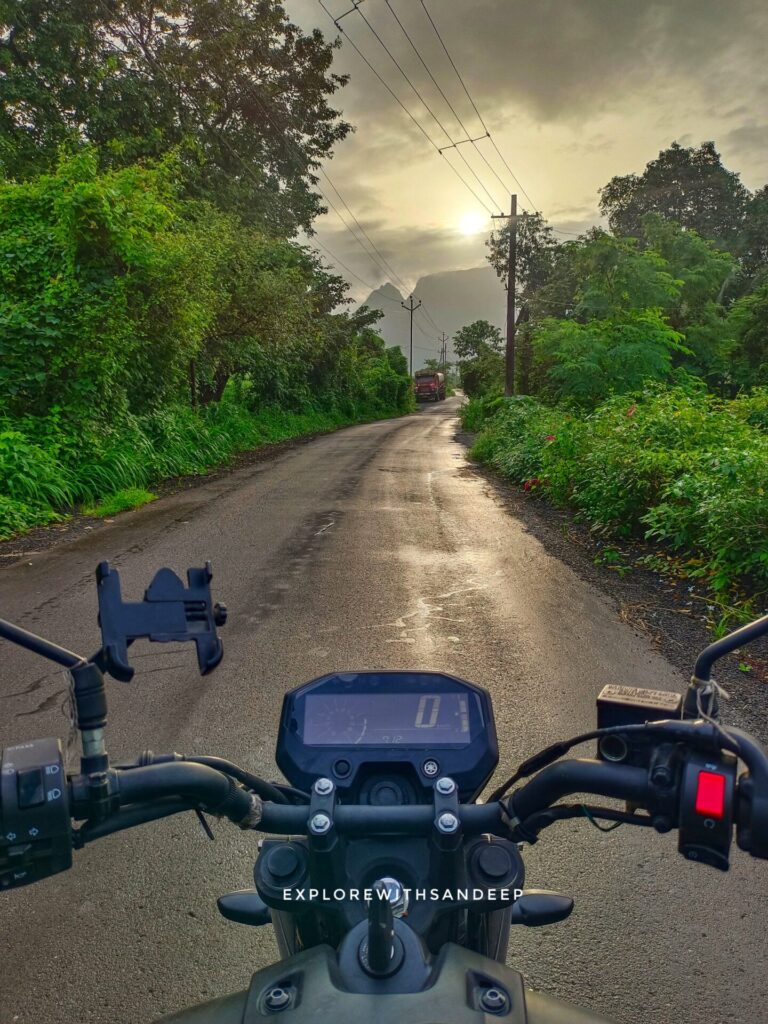
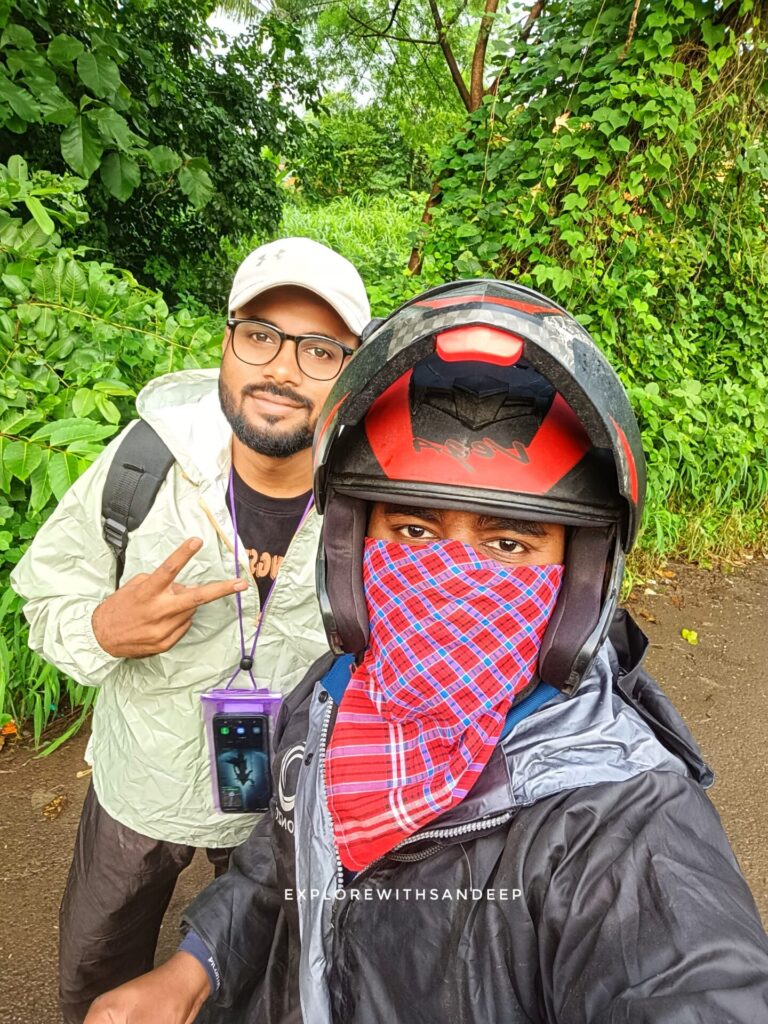
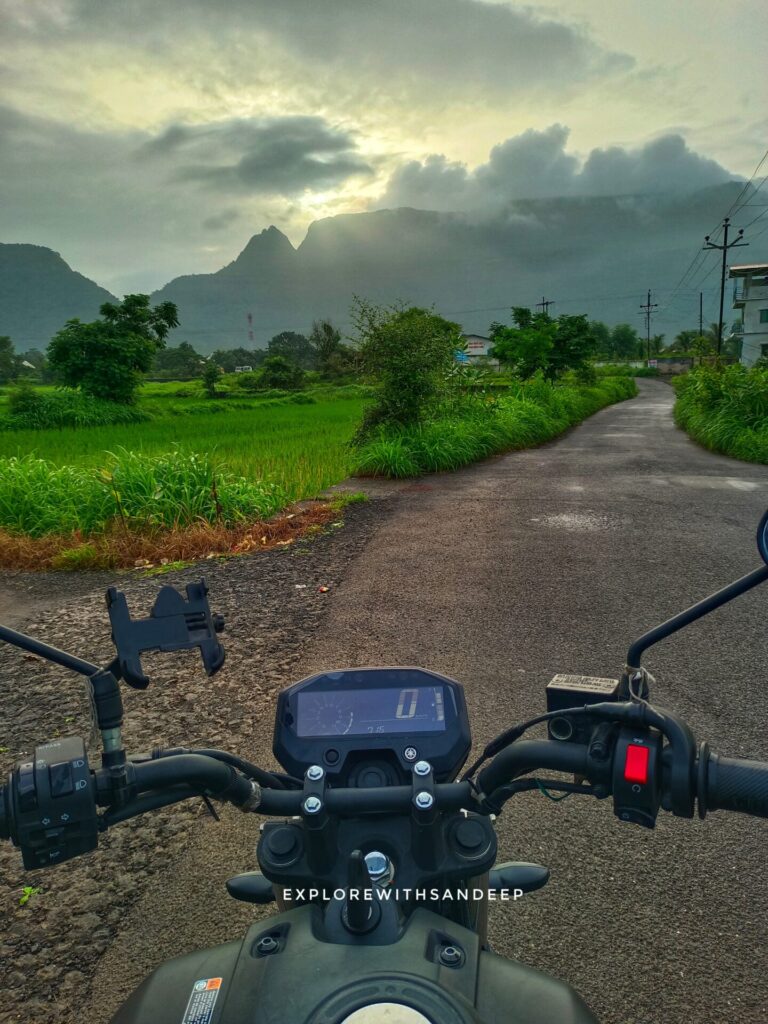
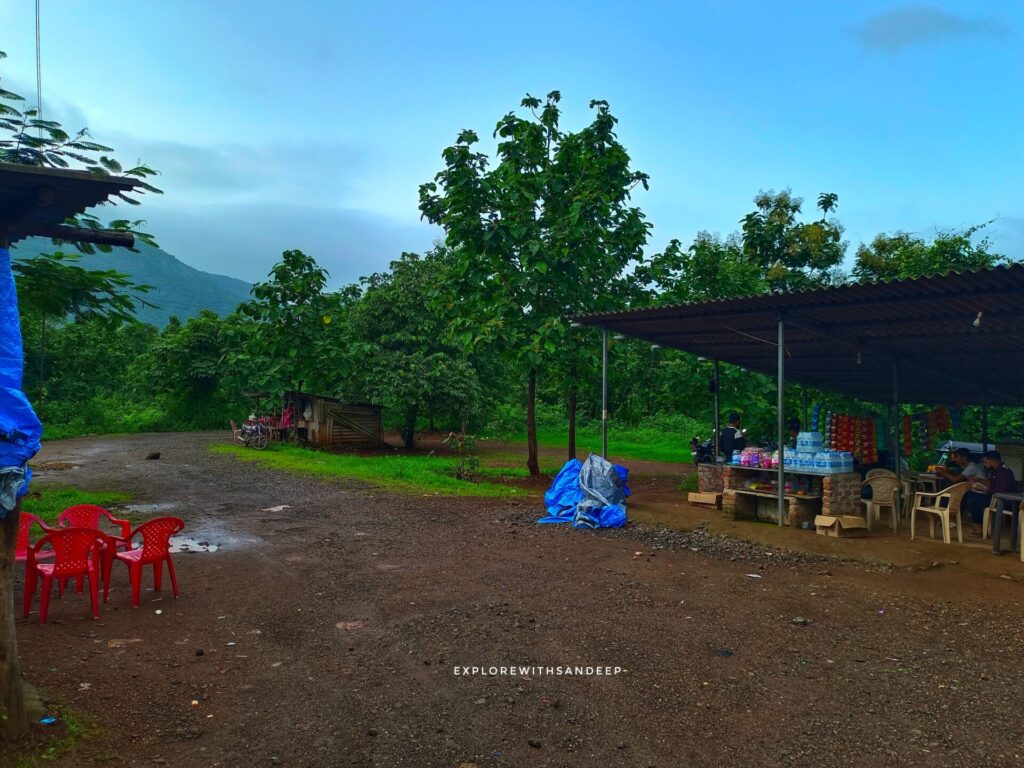
After 1.5 hours of riding, we saw our first view of the huge Kalavantin Durg standing tall against the rising sun – it looked amazing! We reached the base village of Thakurwadi and parked our motorcycle. At the village base, small local food stalls serve tasty vada pav and chai 🥪☕ – the perfect energy boost for the tough trek ahead (because you’ll need all the carbs you can get! 💪).
Trekking Through the Forest
“Chhatrapati Shivaji Maharaj ki Jai!”
That’s how we began our trek, our enthusiastic shouts echoing through the peaceful morning air (probably waking up every bird in a 5km radius 🐦😴).
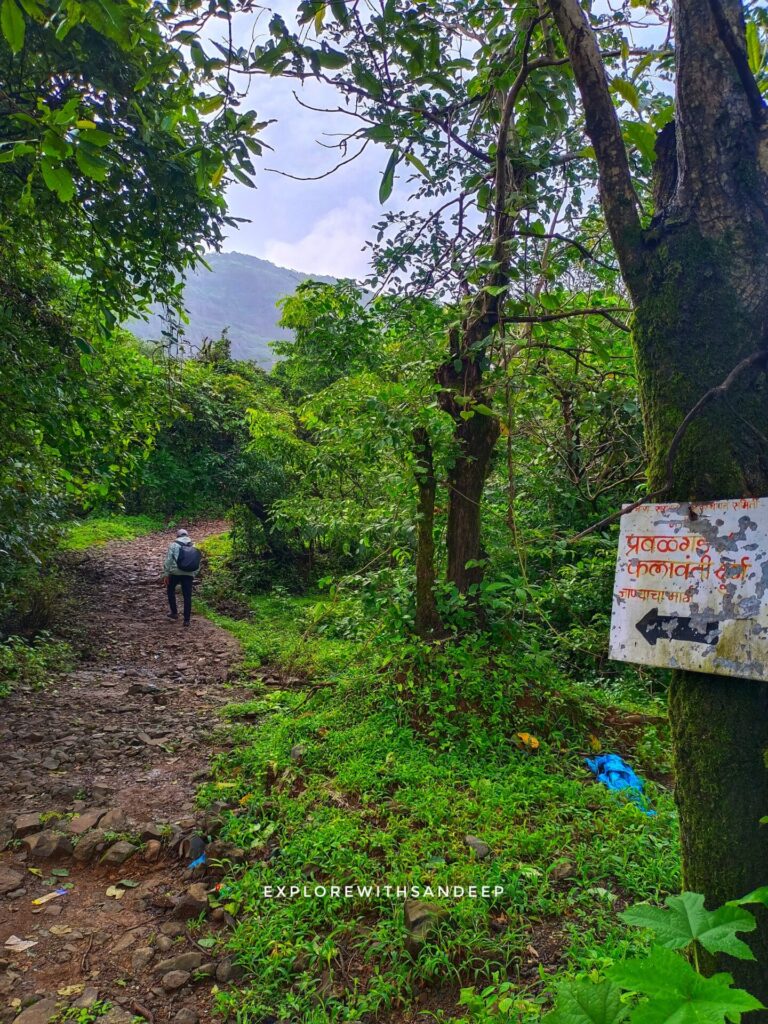
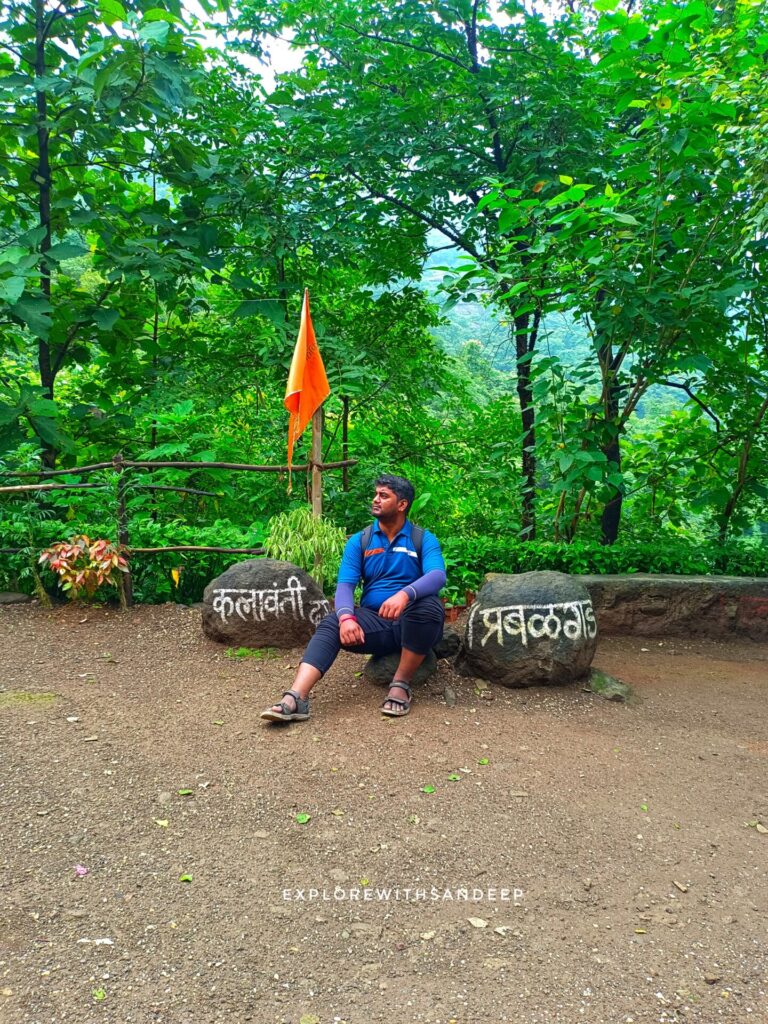
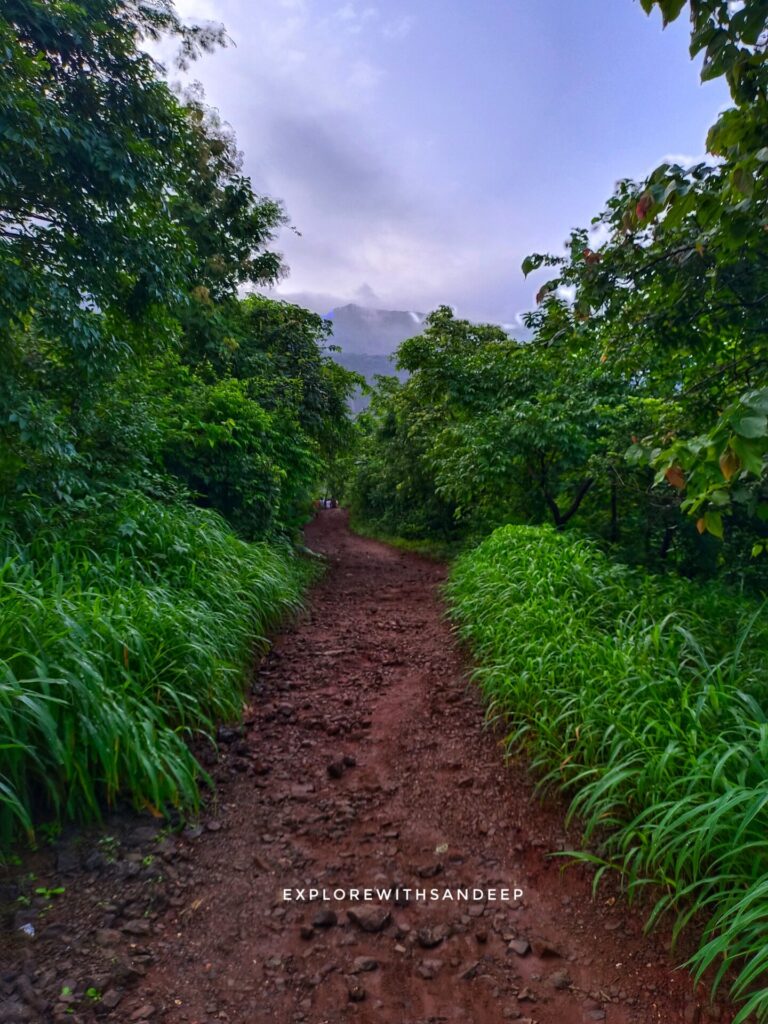
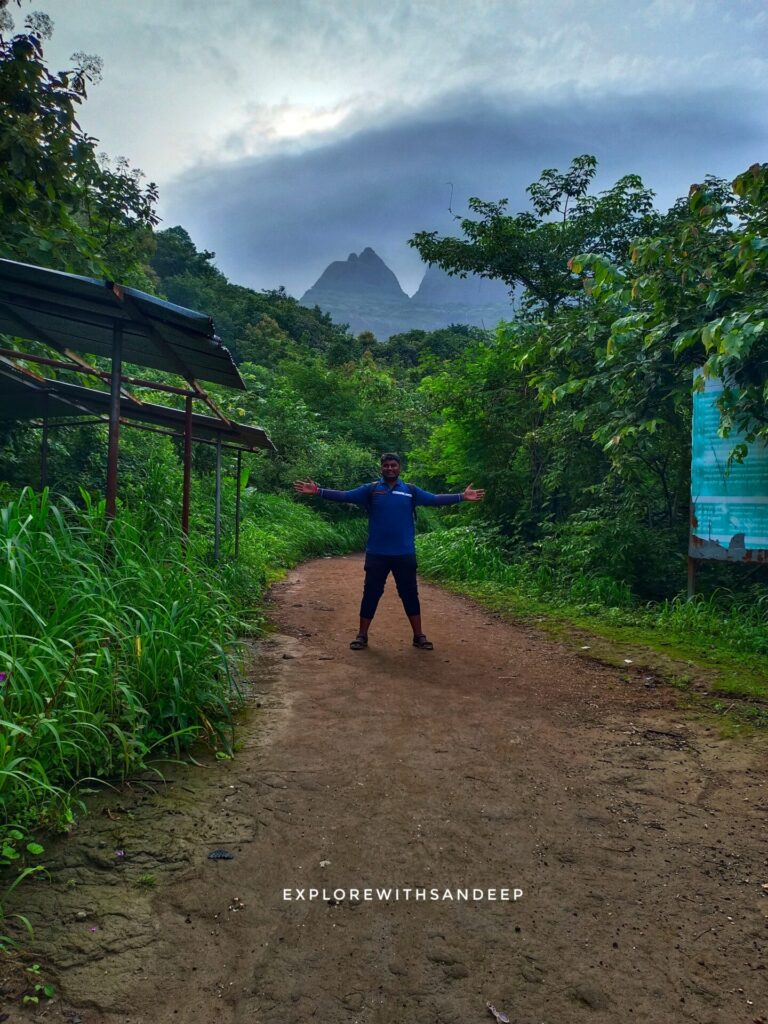
The trail started off easy and clear. Soon, we walked into a dense forest that looked magical after the monsoon rains – everything around us was glowing in bright shades of green 🌿💚. It honestly felt like nature had turned the color setting to full brightness!
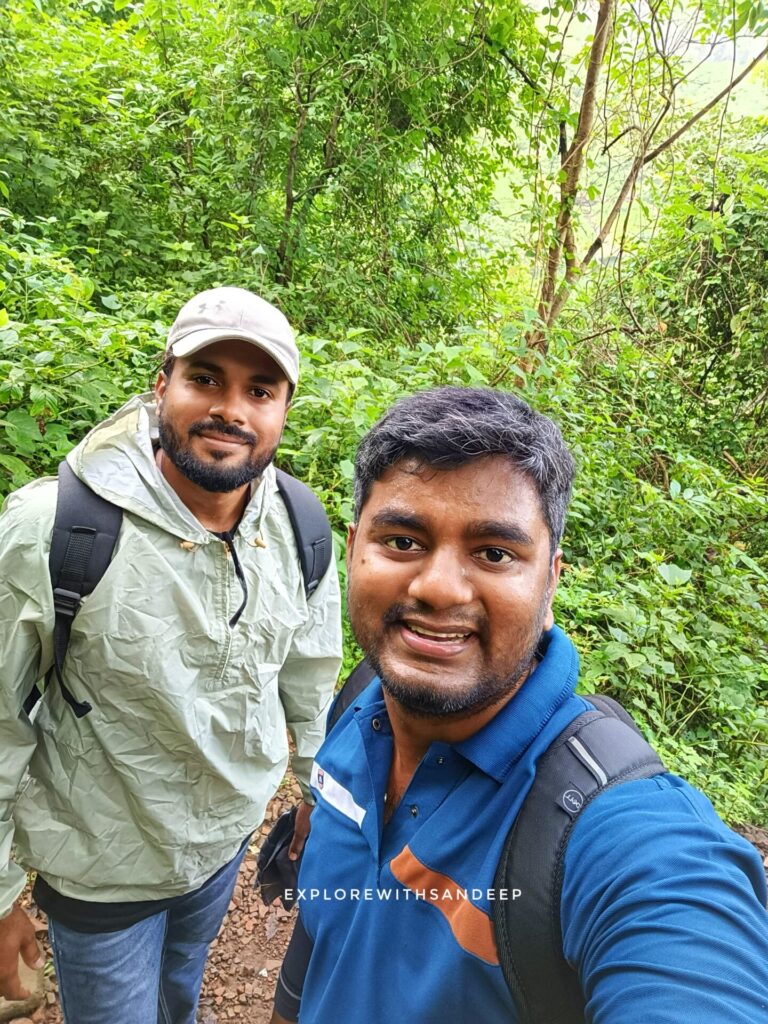
About 45 minutes into our trek, we reached a small refreshment point where two painted stones caught our attention — one with Kalavantin Durg written on it and the other with Prabalgad Fort. 🪨➡️ These stones don’t point in any direction, but their bold lettering makes them perfect for a quick photo and a reassuring reminder that you’re still on the right path (because getting lost in the middle of nowhere would definitely kill the vibe 📸🤳).

An hour later, we discovered a naturally formed tree branch that resembled a seesaw 🌳⚖️. Like kids, we couldn’t resist playing on it for a few minutes – even serious trekkers need their playful moments! (Adults are just kids with bigger problems and smaller patience 😄)
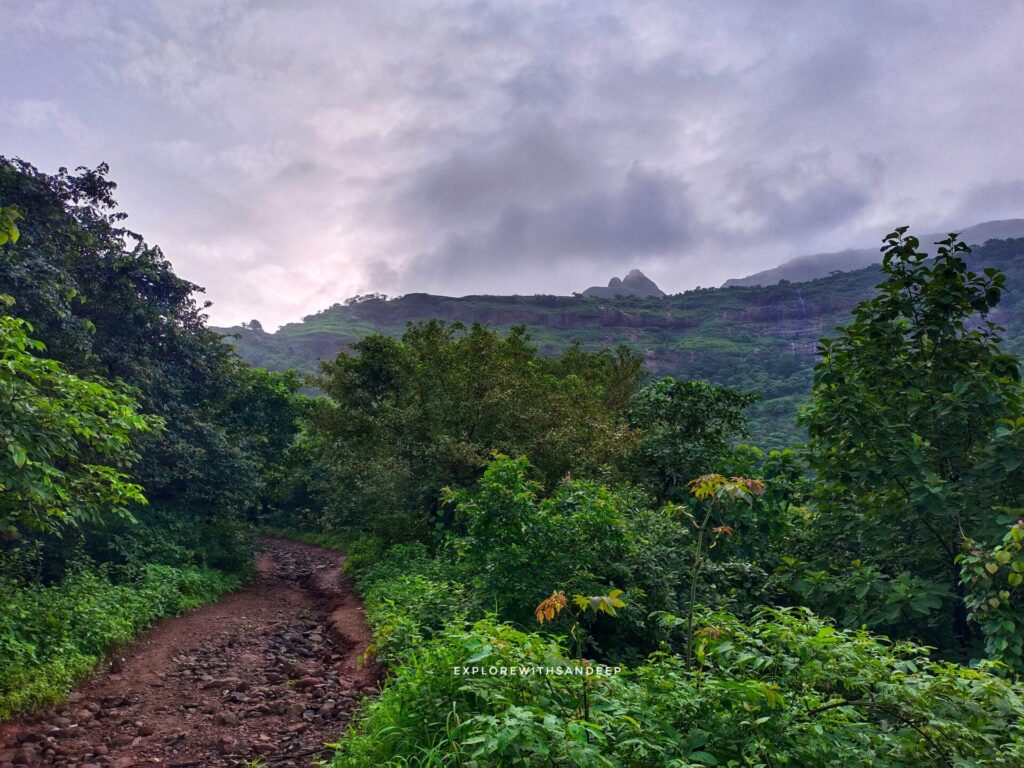
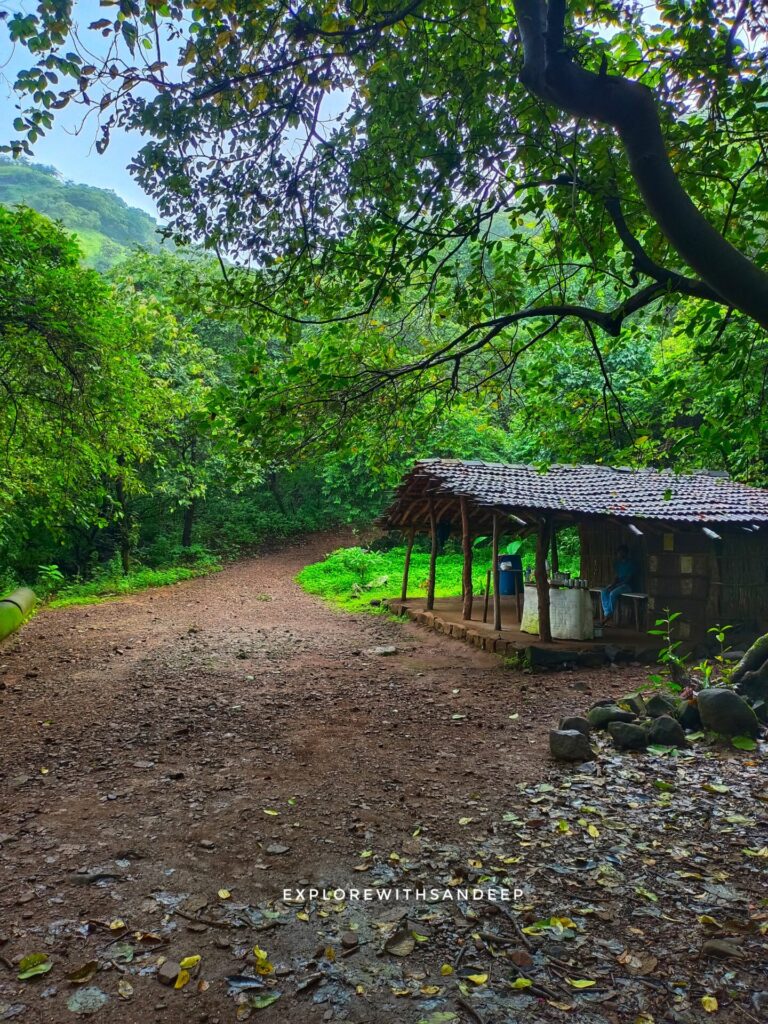
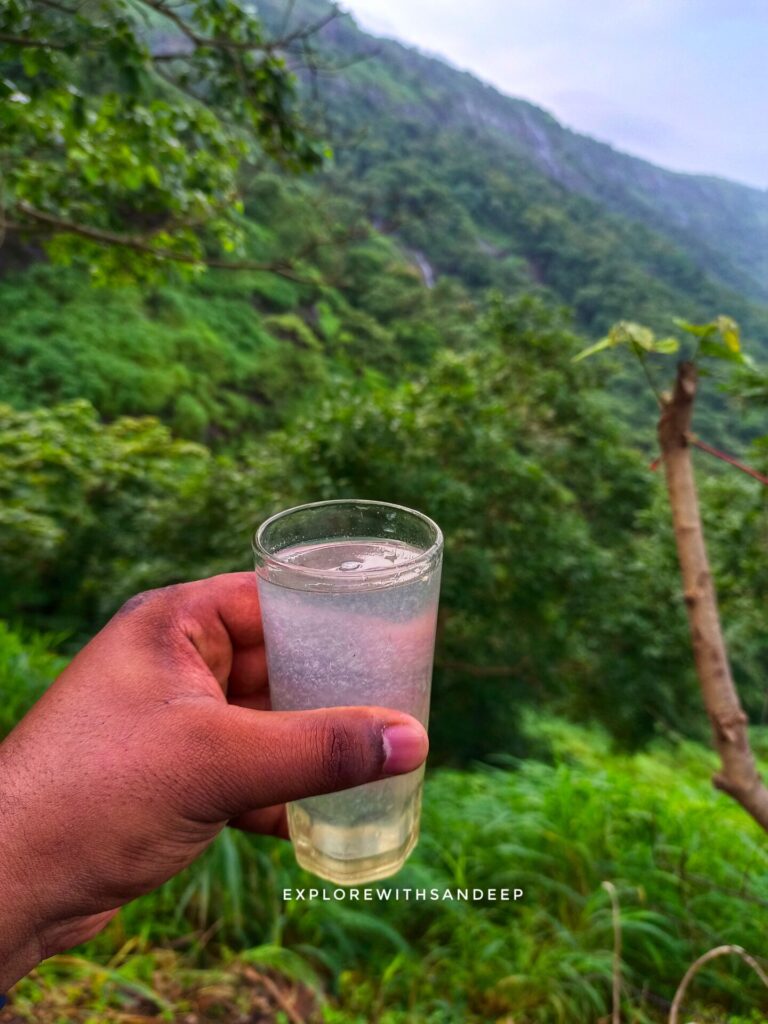
We stopped at a small snack stall run by friendly villagers from Thakurwadi and refreshed ourselves with cold lemon juice 🍋🥤 (which tasted like liquid gold after all that walking!).
The Trail Gets Challenging 📈💪
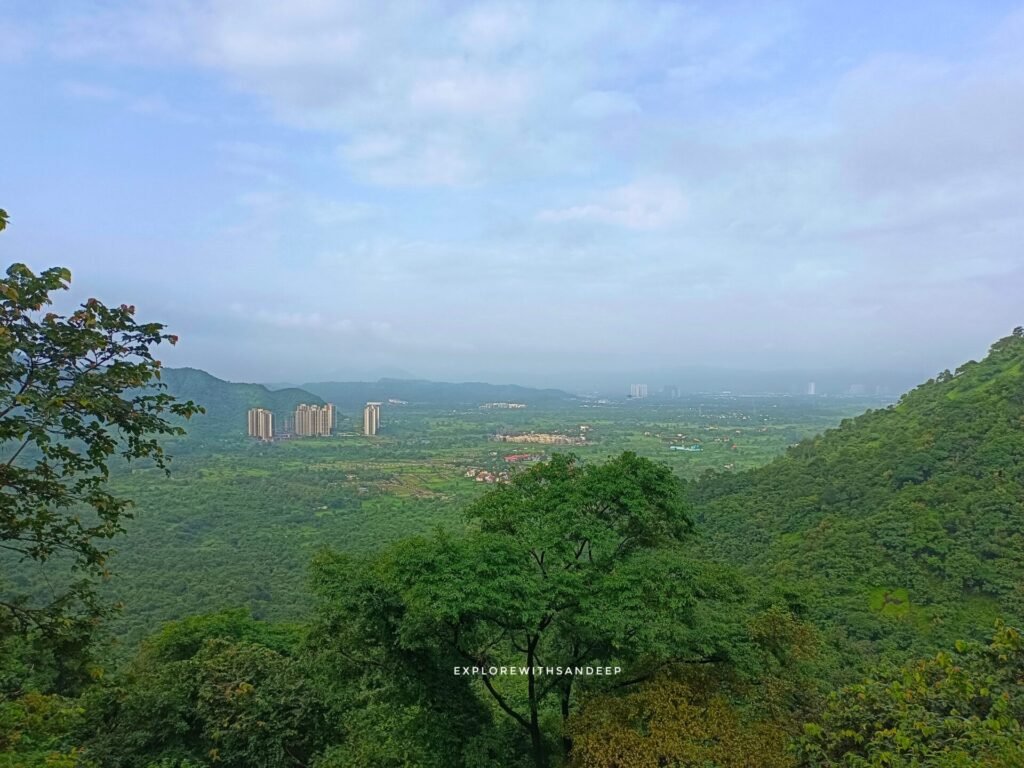

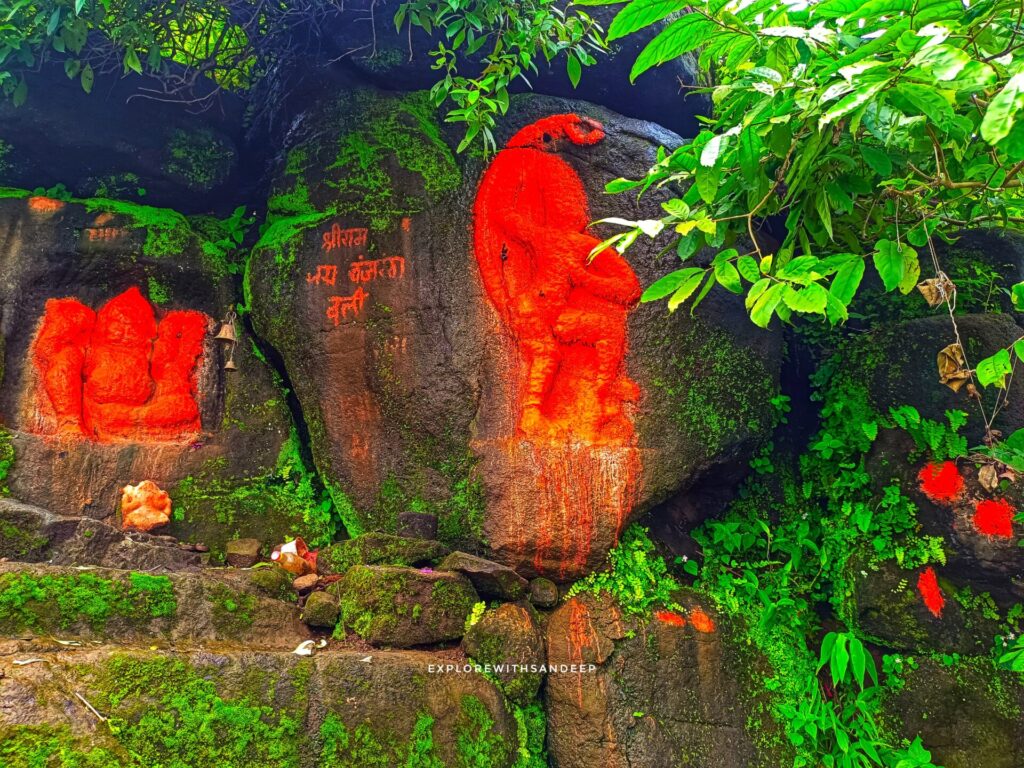
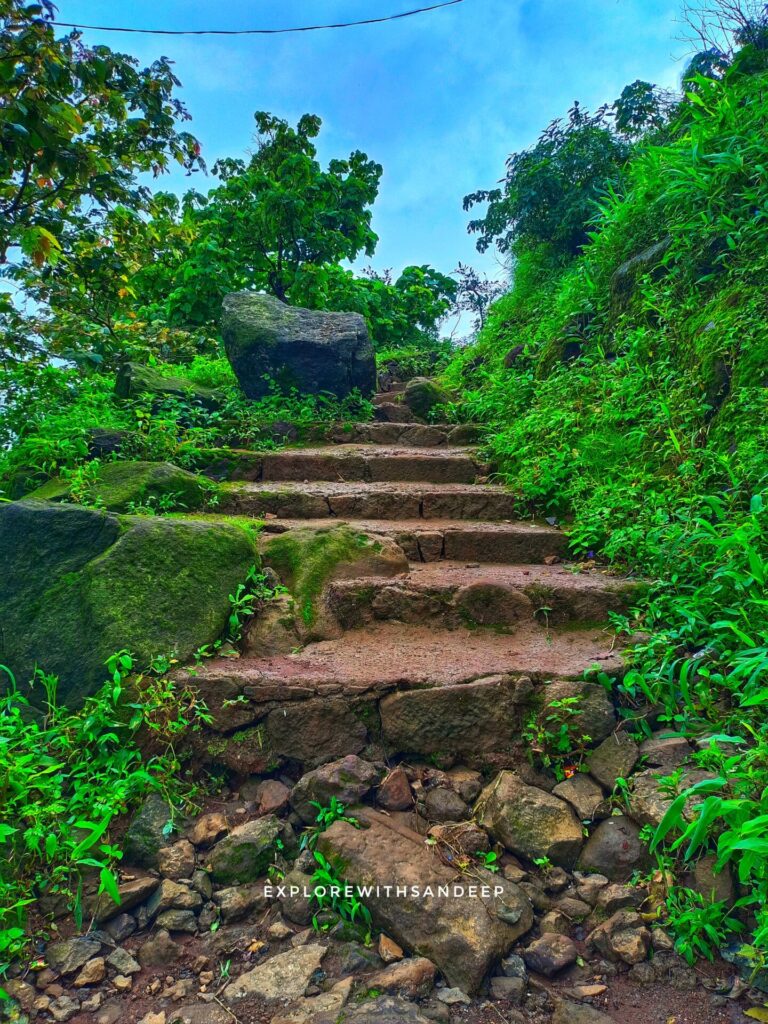
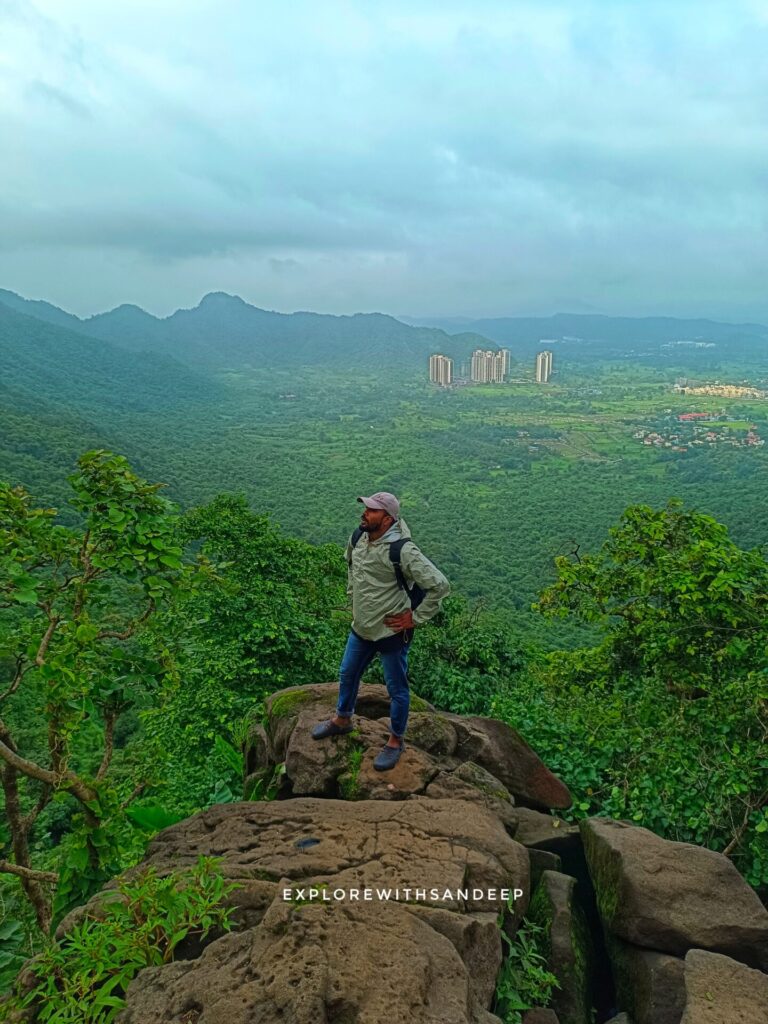
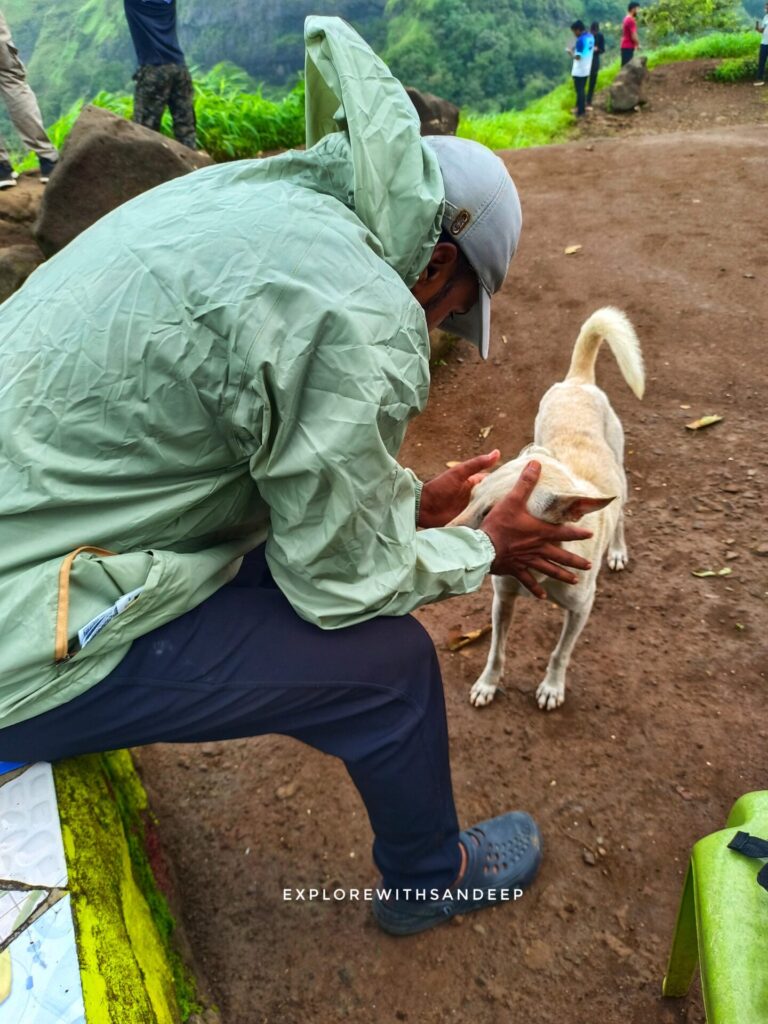
As we climbed higher, we encountered a stone idol of Lord Hanuman in his Chapeddan form, along with a beautifully carved Ganpati sculpture in the nearby rocks 🐵🐘. We took blessings from both deities before continuing our ascent.
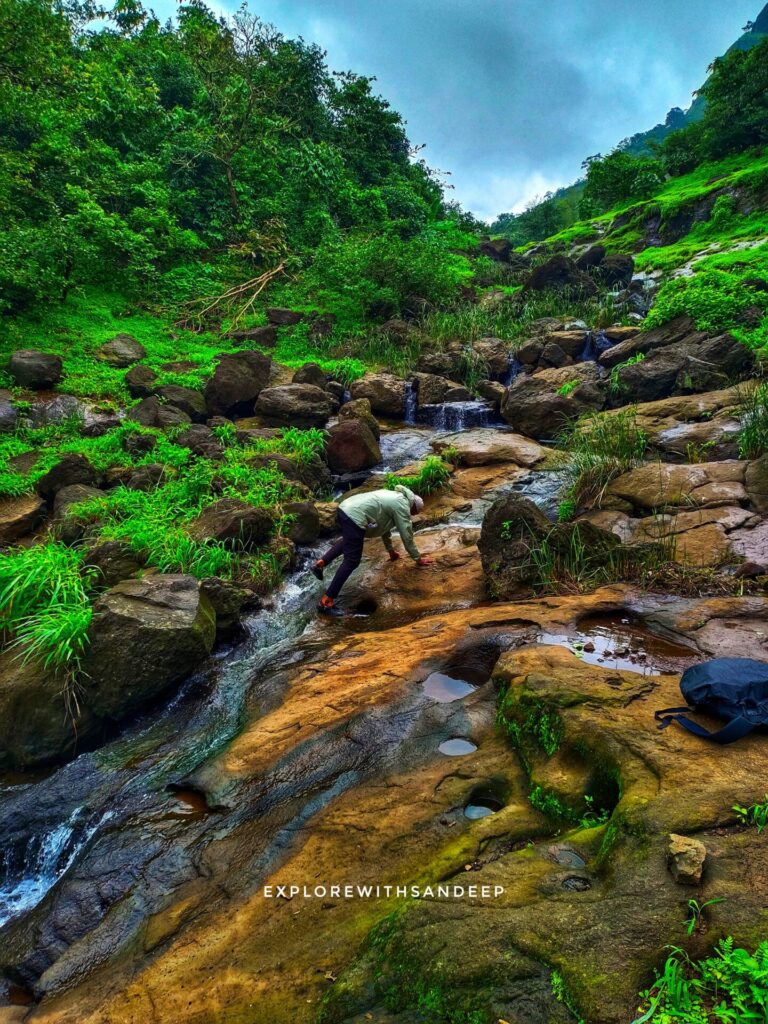
Close by, a small waterfall provided the perfect opportunity to wash our faces and feet in the refreshing cold water – an instant energy booster! 💦😌 (Nothing beats mountain water when you’re sweating like you’re in a sauna!)
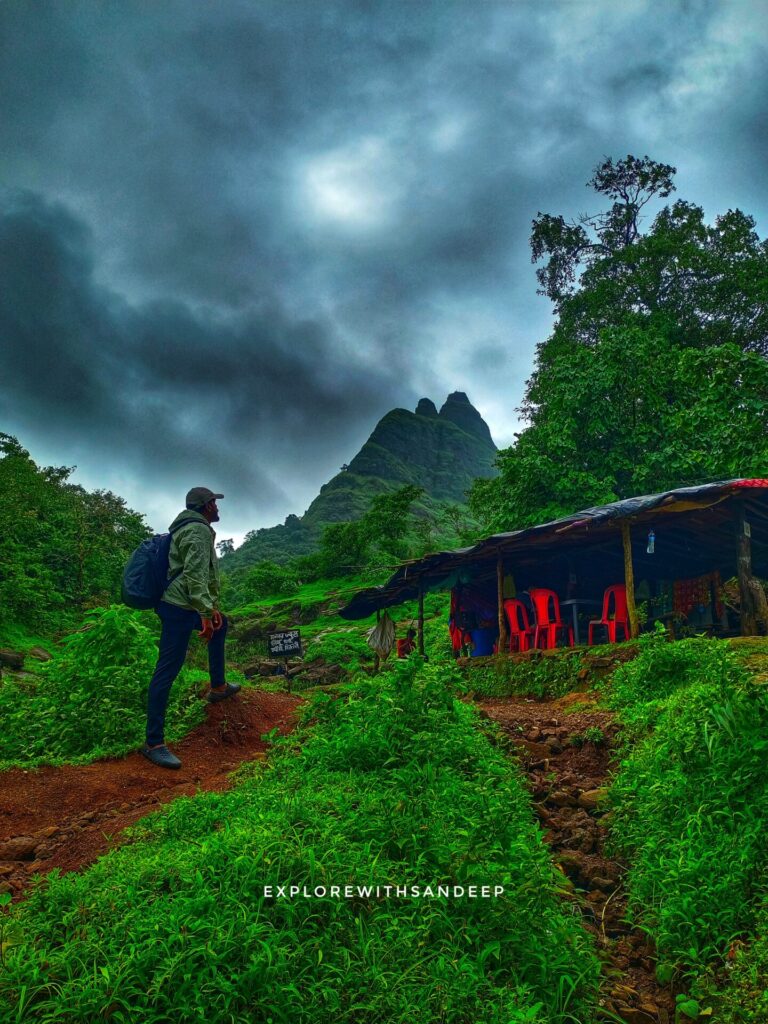
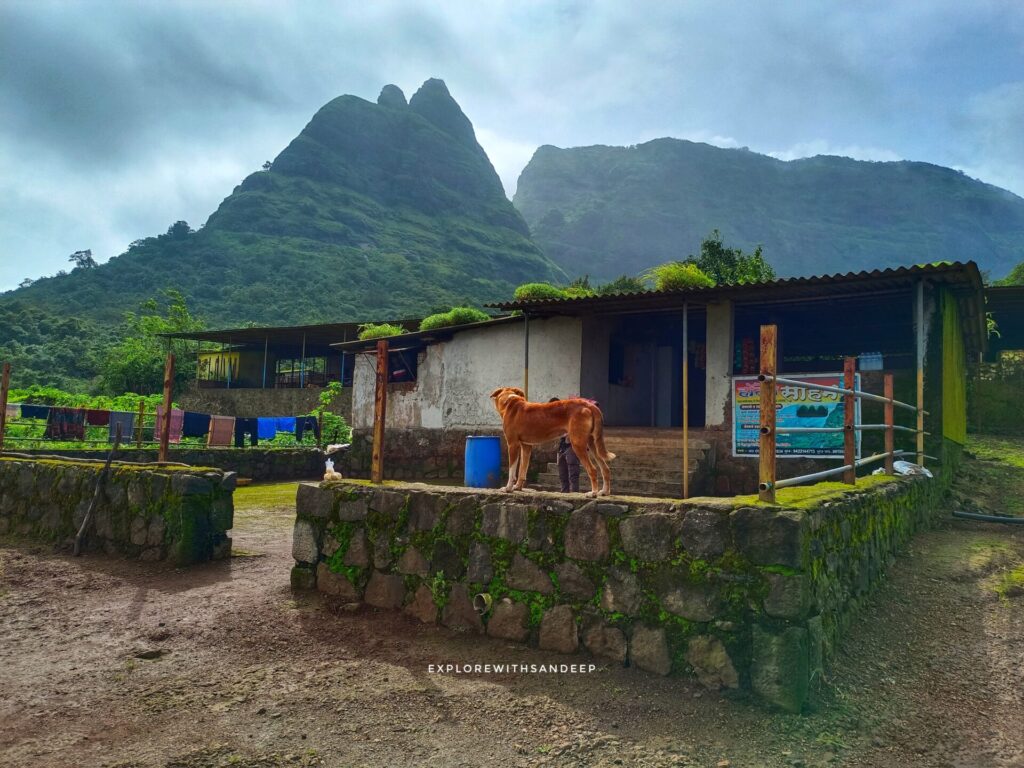
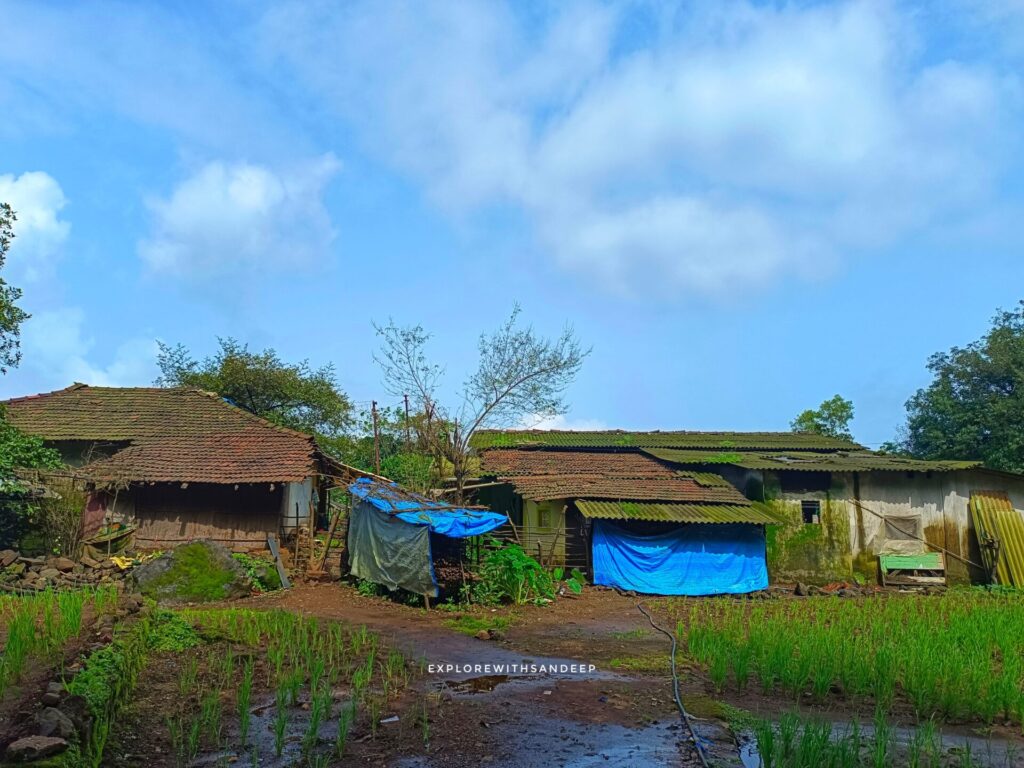
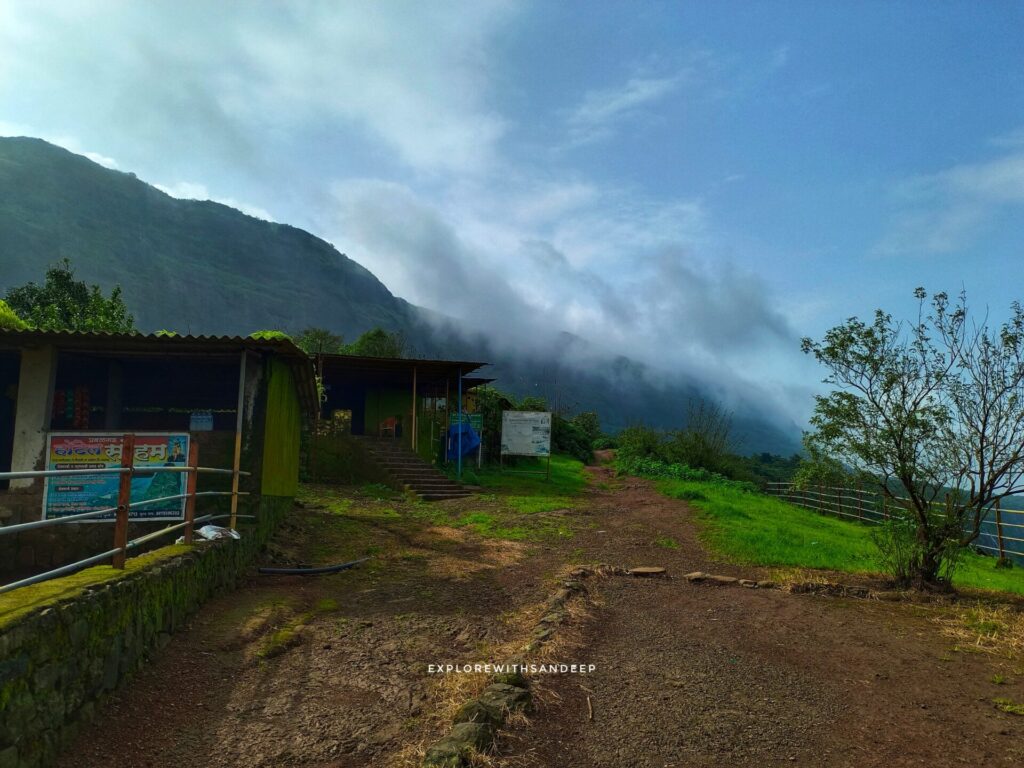
Here’s something that surprised me: there’s actually a small settlement built right on the mountainside, just below the fort! 🏘️⛰️ Curious, I asked one of the local residents why they chose to live at such a remote, difficult location. He smiled warmly and explained, “Our families have lived here for generations. We make this climb daily – it’s simply our way of life.”
These villagers trek 2.5 hours each way to reach the main Thakurwadi village below for work and supplies, then return home up the mountain. It’s their daily routine! 🚶♂️🔄 The dedication and strength of these people is truly inspiring (and made me feel like a complete weakling for complaining about my morning jog 🏃♂️😅).
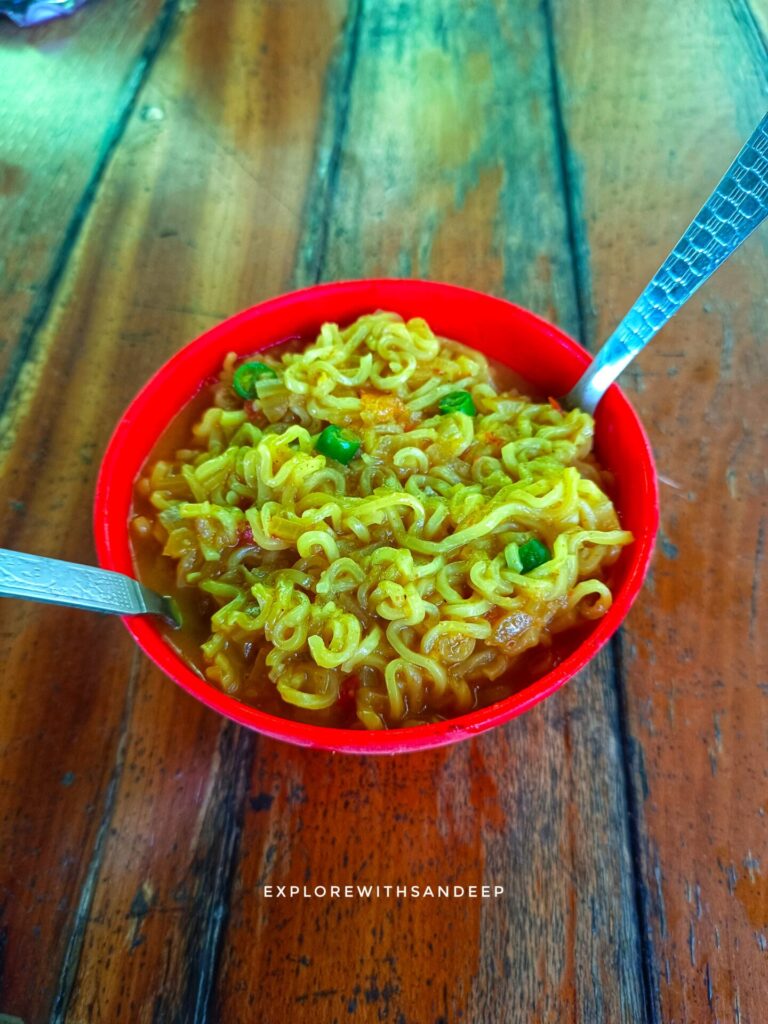
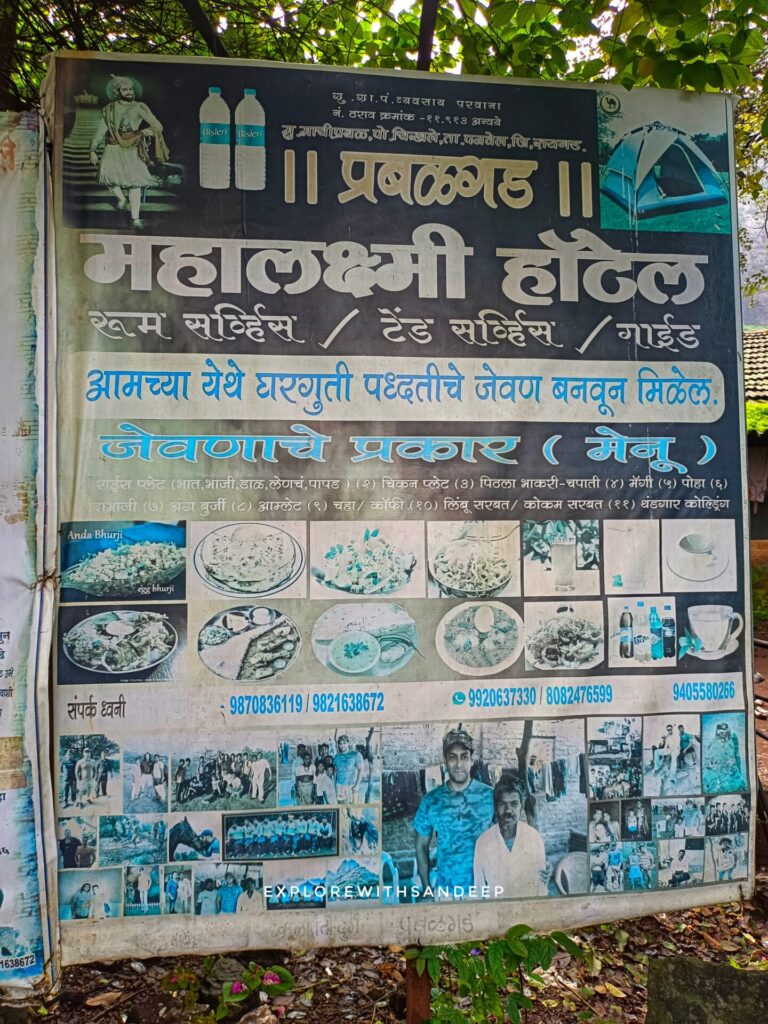
There are also some basic accommodation options and food stalls at this level. One of the establishments is locally famous for having been visited by Bollywood star Salman Khan.
The Hidden Cave Discovery 🕳️🔍
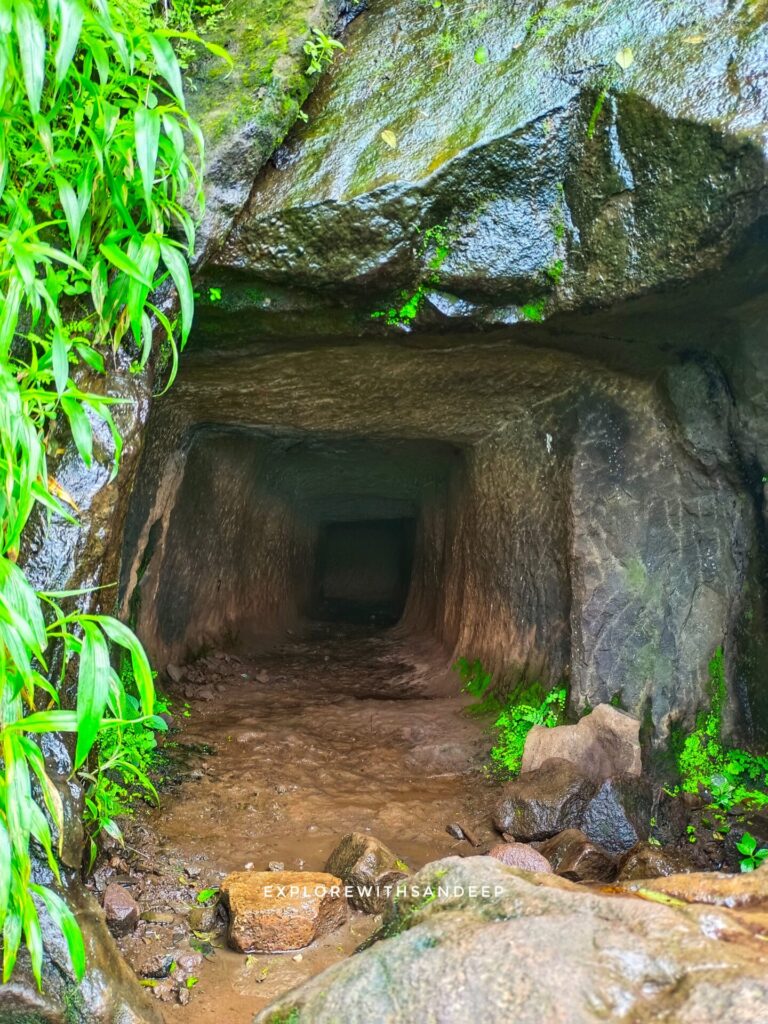
Just before reaching the famous Kalavantin steps, there’s a small cave carved into the mountain’s edge that many trekkers miss because it’s slightly hidden from the main path. This 15-20 feet long cave was historically used by ancient watchmen and monks for shelter and meditation 🧘♂️.
While not particularly large, this cave adds a mystical element to the entire trekking experience 🔮. It’s an ideal spot to pause, catch your breath, and appreciate the raw natural beauty surrounding you (and maybe question your life choices that led you to climb a mountain 🤔😅).
The Legendary Kalavantin Steps 🪜💀
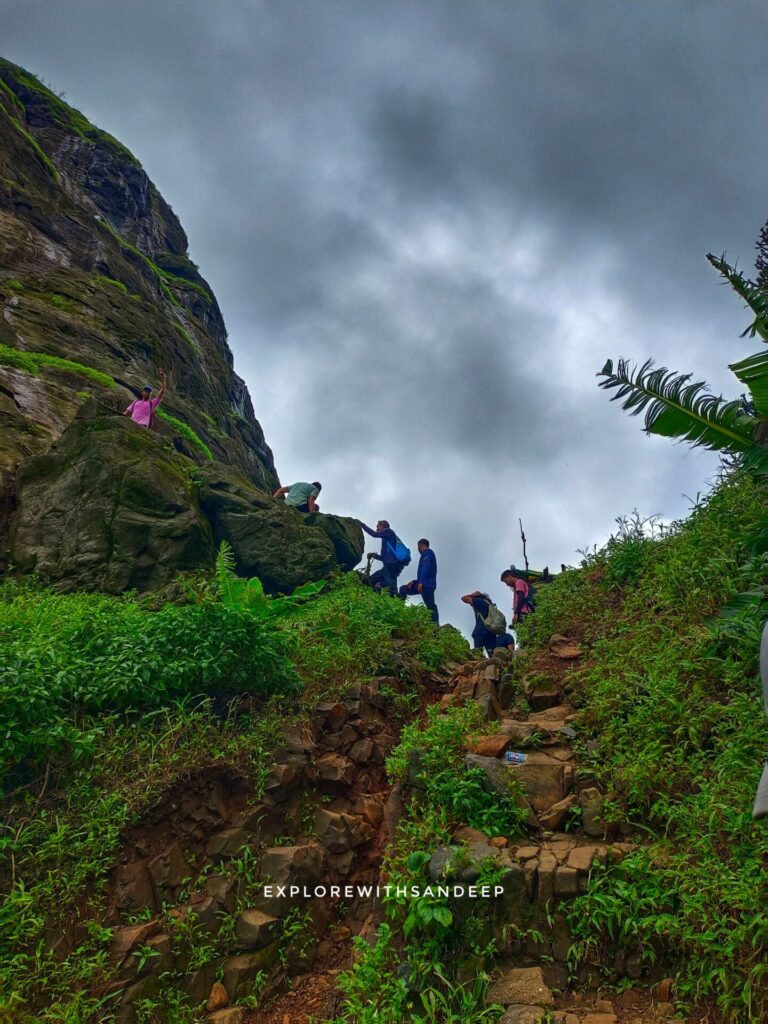
After 3 hours of steady trekking, we finally reached the infamous Kalavantin rock-cut steps – the feature that makes this trek legendary among adventure enthusiasts!
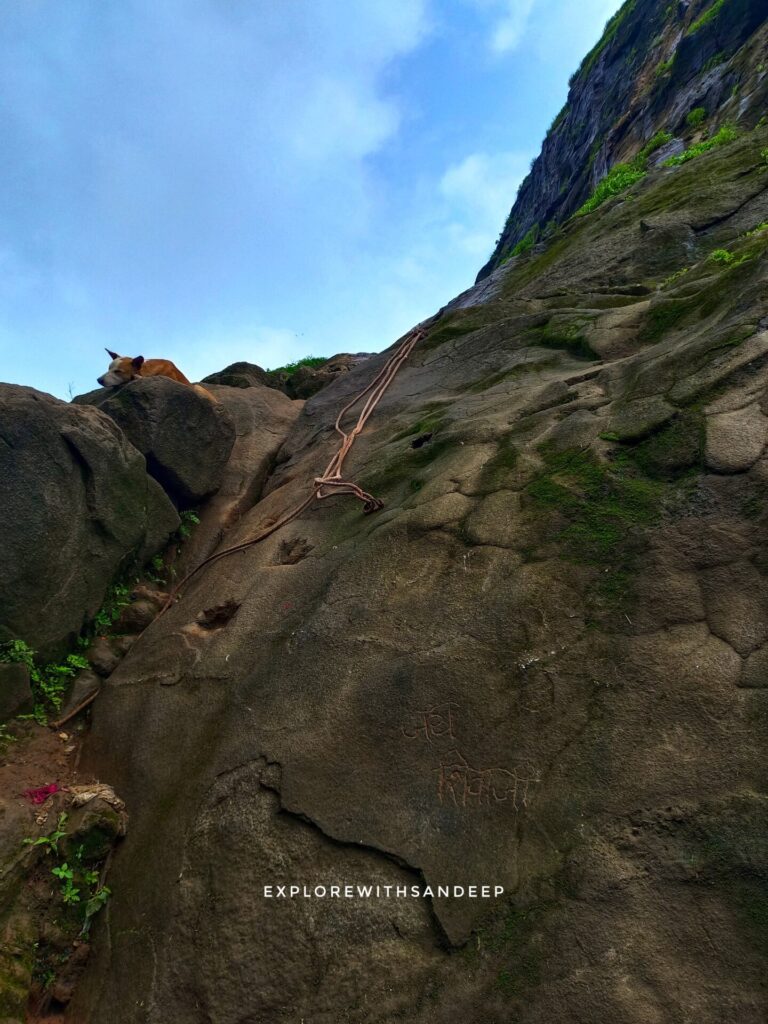
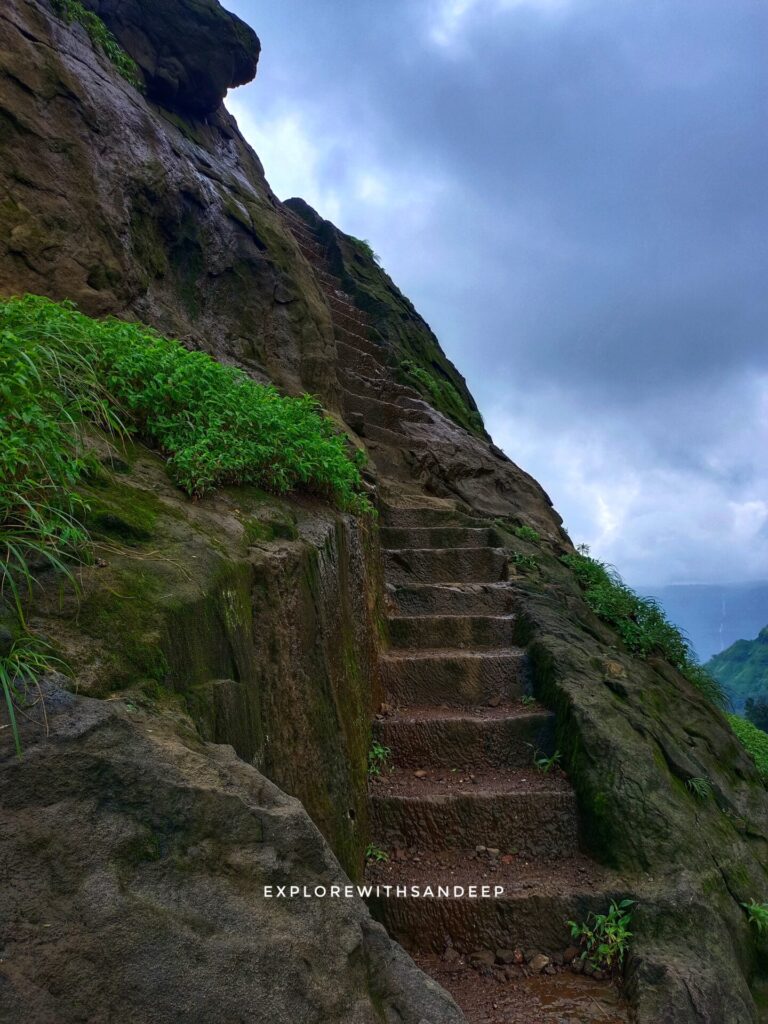
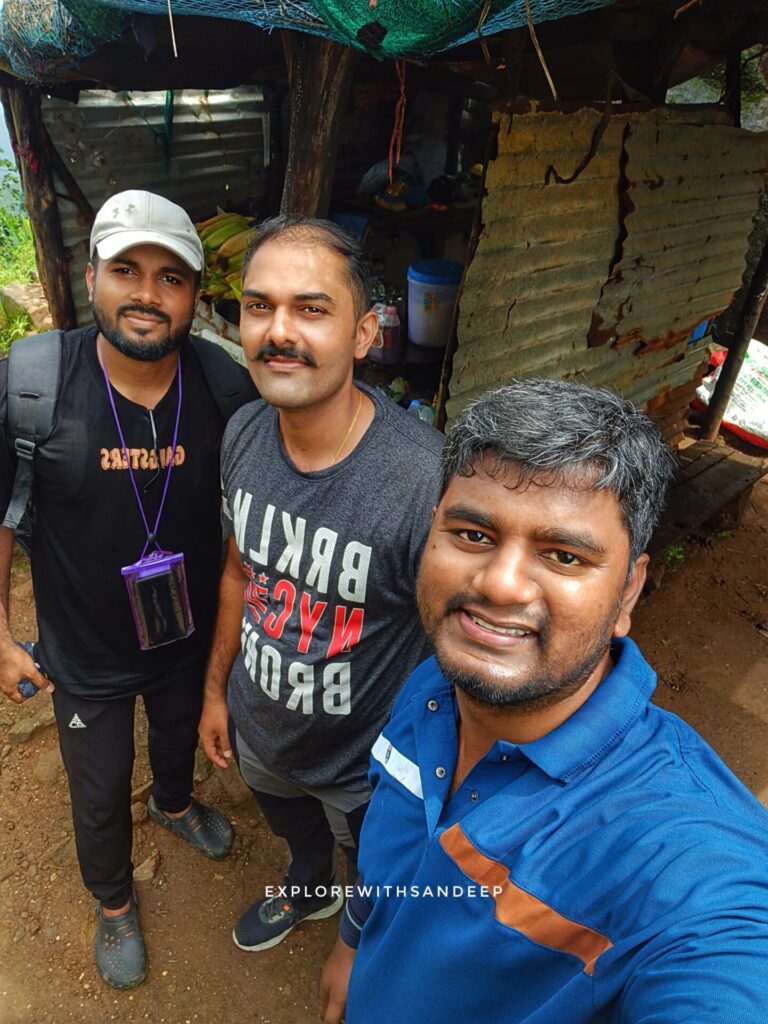

These steps are carved directly into the solid mountain rock with no safety railings and feature an almost vertical dro on one side 📐⬇️. Here, we met Parmeshwar Bhagat, a commando in the Indian Army who had just completed the climb and was waiting for his fellow trekkers (basically, a real-life superhero making the rest of us look like couch potatoes 🦸♂️🛋️).
After another round of energizing lemon juice 🍋⚡ (hydration is crucial for survival, and lemon juice is basically liquid courage!), we tackled the intimidating staircase.
Each step is roughly 2 feet in height 📏, and during monsoon, they become wet and extremely slippery 💦🧊. You must climb using both hands and feet, like navigating a real-life adventure movie scene (except there’s no stunt double and the director is Mother Nature herself 🎬🌿). One wrong move could have serious consequences, so we avoided looking down at the dizzying drop below (because ignorance is bliss when you’re clinging to a rock face! 👀🚫).
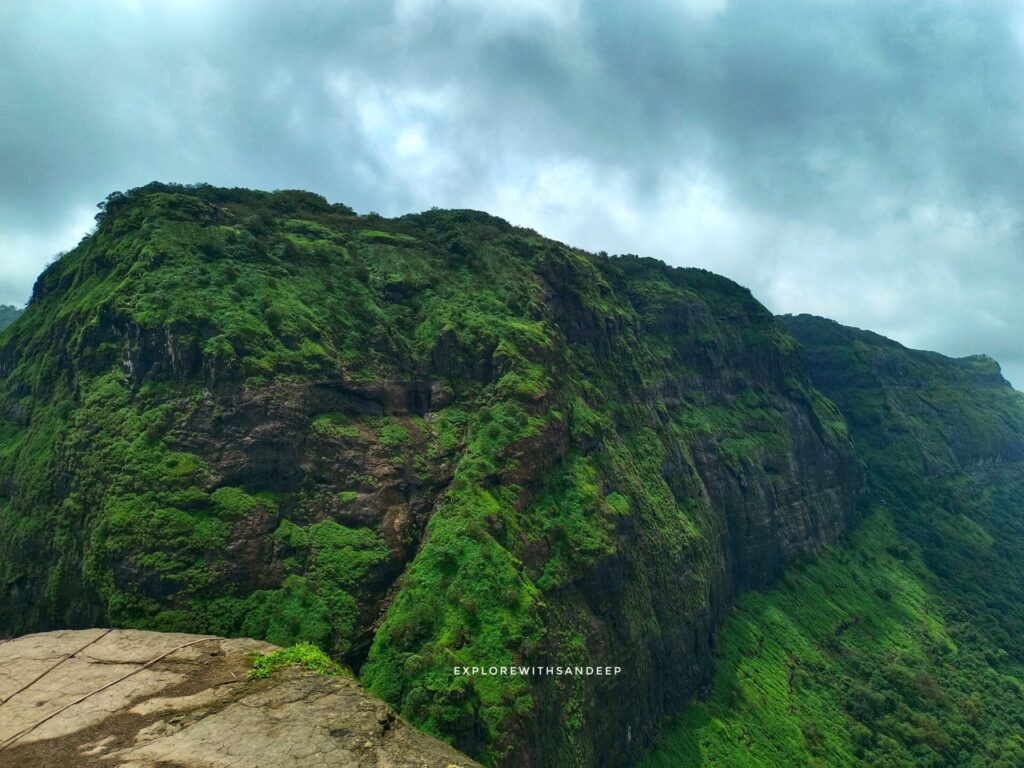
Halfway up these treacherous steps, we were rewarded with an absolutely spectacular view of the Prabalgad Fort plateau spread out below us 🏔️👁️ – pure magic that made every challenging step worthwhile (and temporarily made us forget we still had to climb down! 😅).
The Final Challenge 🏁⚡
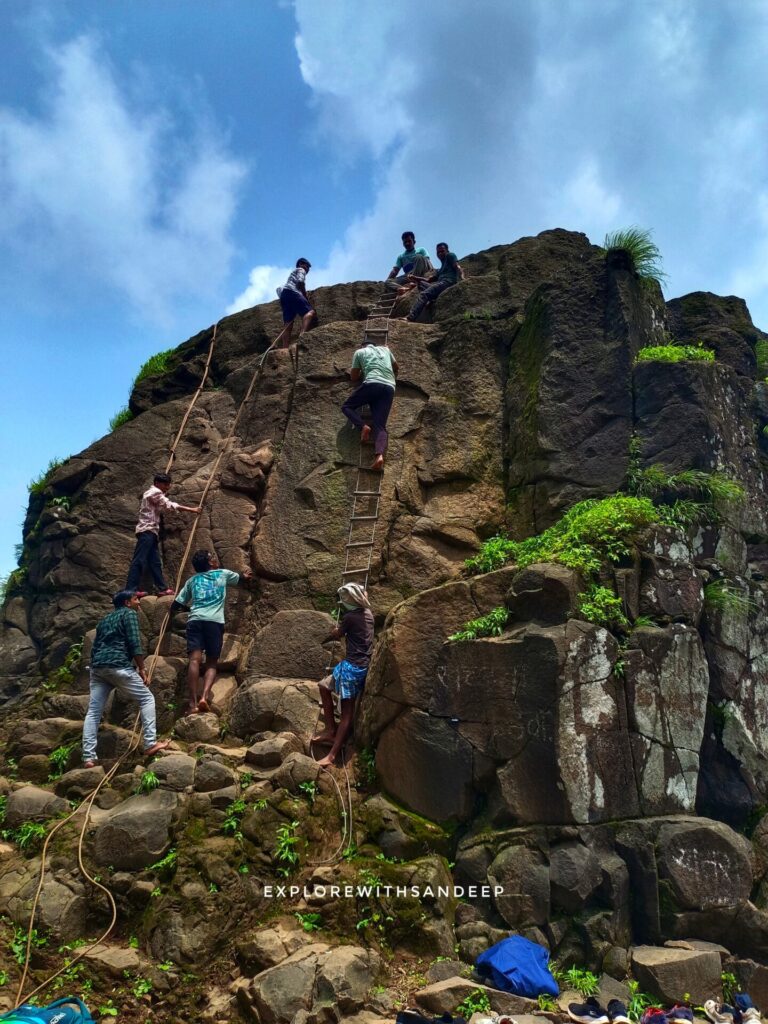
Just when we thought we had reached the summit, another surprise awaited us – a final 30-40 foot high rock formation standing like nature’s ultimate test! 🪨🎯
To reach the true summit, you must scale this rock using metal stairs and ropes installed by local villagers 🪜🪢. This final climb is equally thrilling, with strong winds and steep drops on all sides (basically, it’s like being in a wind tunnel while rock climbing 💨🧗♂️). The locals charge a nominal fee of ₹30 for maintaining these safety installations – money well spent for such an incredible experience (and honestly, I would have paid ₹3000 at that point! 💰😄).
The Summit Victory 🏆👑
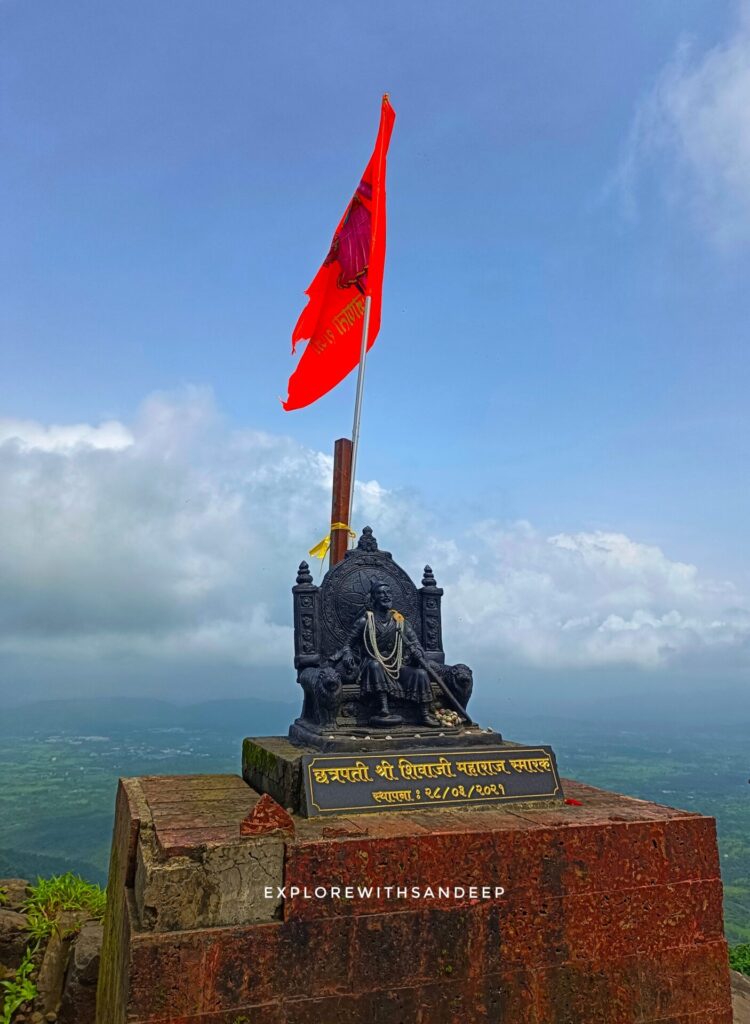
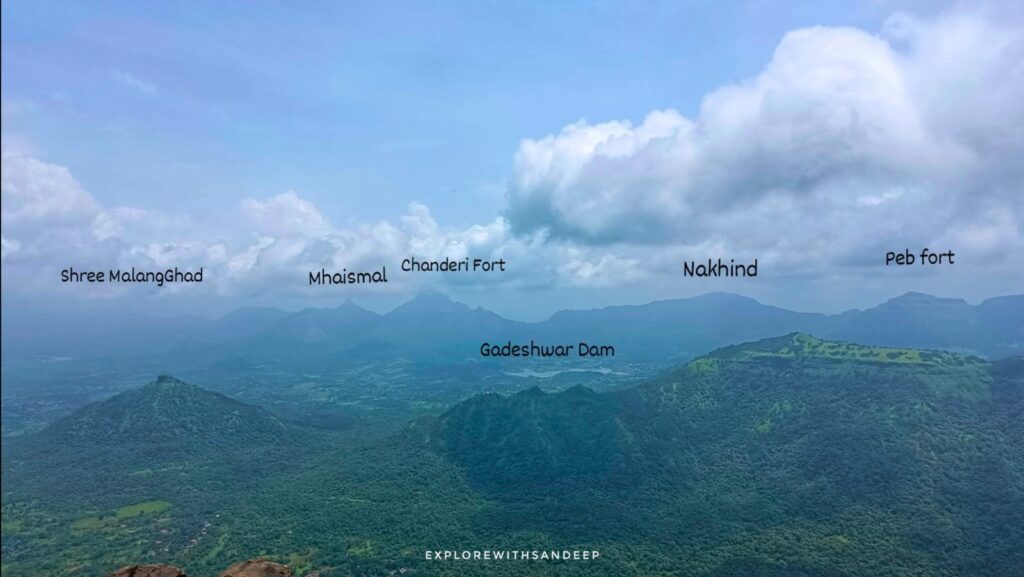
At the very top sits a magnificent idol of Chhatrapati Shivaji Maharaj on his throne 👑🏰. From this vantage point, you can identify several surrounding forts: Malanggad, Nakhind, Peb Fort, Chanderi Fort, Karnala Fort, Mhaismal, and even glimpse the Matheran hills 🏔️👀, all surrounded by cascading waterfalls and lush valleys (like nature’s own IMAX theater, but with better snacks! 🎬🍿).
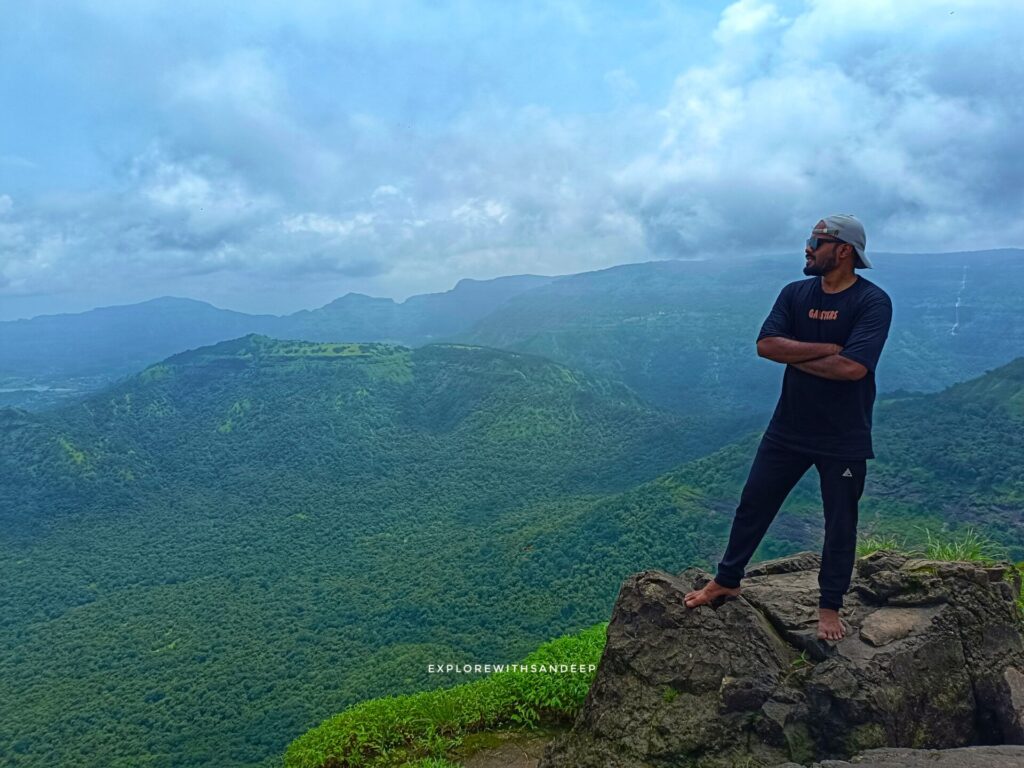
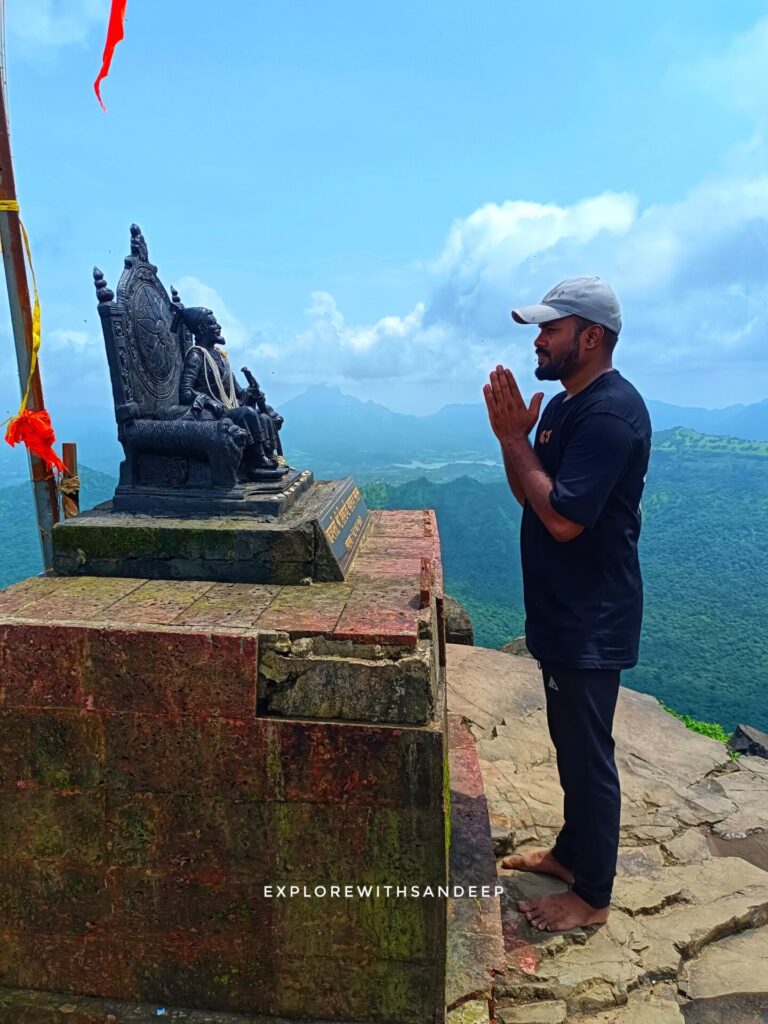
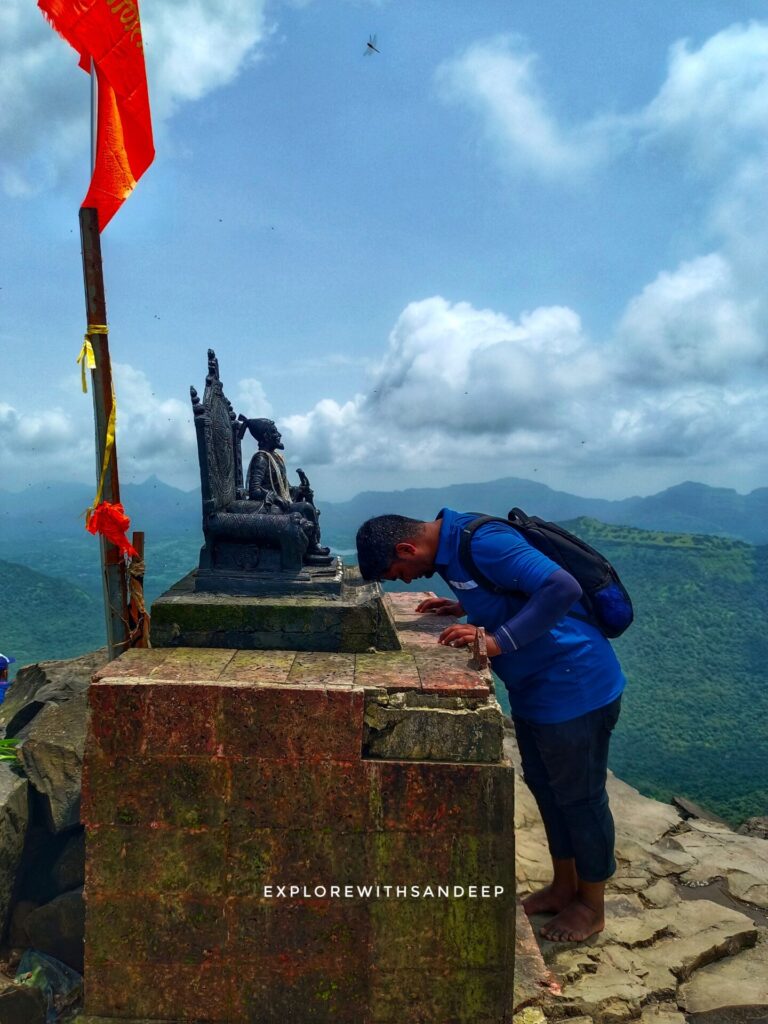
We spent considerable time at the summit – capturing photographs 📸, absorbing the incredible 360-degree views 🌍, and letting the cool mountain breeze refresh us after our challenging climb 🌬️😌. The combination of perfect weather, the majestic Sahyadri mountain range, the peaceful atmosphere, and the presence of Shivaji Maharaj’s idol created a moment of pure bliss that every trekker dreams of experiencing ✨💫.
This is what true happiness means to me – standing above the clouds, having earned this view through determination and effort (and a lot of heavy breathing! 😮💨☁️).
The Descent – Not just steep, but scary steep 😵🧗♂️
The journey down proved to be significantly more challenging than the ascent! What had felt like an exciting climb now appeared as a nearly vertical drop 📐⬇️. The narrow, uneven steps carved into the mountain rock were tricky to navigate, with nothing substantial to grip except small holds in the rock face (and our rapidly depleting confidence! 😅🤏).
We descended extremely slowly, taking each step with careful precision and gripping whatever small edges we could find to steady ourselves 🐌🤲. Our legs were already fatigued from the climb, and now every muscle had to remain constantly alert 🦵⚠️. The same path we had climbed with excitement now tested our nerves and patience as we made our way down (and my knees started filing a formal complaint! 😩📝). Even the mountain wind seemed stronger and more unsettling during the descent 💨😬.
Finally, we reached the base village safely, started our motorcycles, and began our return journey to Mumbai 🛵🏙️ – carrying with us the immense pride of conquering one of Maharashtra’s most challenging treks: Kalavantin Durg. We were tired, slightly sore, and extremely hungry, but smiling from ear to ear 😴😢🍽️😊. This wasn’t just a trek; it was an adventure packed with thrills, fears, fun, and memories that will last a lifetime (and enough stories to bore our friends for years! 📖😄).
Essential Trekking Tips 💡📝
Safety Equipment:
– Wear high-quality trekking shoes with excellent grip 👟
– Carry sufficient water 💧 (minimum 2 liters per person – dehydration is not a cute look)
– Pack energy snacks and ORS packets 🍫⚡
– Bring a basic first-aid kit 🩹
Timing and Planning:
– Start early (before 6 AM) ⏰ to avoid afternoon heat and crowds (and to have bragging rights about your dedication 😎)
– Never attempt this trek alone 👥 – always go with experienced companions or a certified guide (misery loves company, especially on mountains!)
– Check weather conditions before departure 🌤️ (Mother Nature can be moody)
– Inform someone about your trekking plans and expected return time 📱 (so they know when to start worrying)
Respect and Responsibility:
– Respect local villagers and their way of life 🙏 (they’re basically mountain ninjas)
– Follow Leave No Trace principles 🗑️♻️ – carry all garbage back with you (the mountain has enough problems without your chip packets)
– Don’t attempt risky selfies or stunts 🤳❌ – those steps are not the place for social media photos (your Instagram can survive without that death-defying shot)
– Support local economy by purchasing refreshments from village vendors 🏪💰 (their lemonade tastes like liquid heaven anyway!)
How to Reach Kalavantin Durg 🚗🚂
Location Details:
Kalavantin Durg is located in Panvel Taluka, Raigad district, Maharashtra 📍. Distances: 20 km from Panvel, 30 km from Karjat, 60 km from Mumbai, and 120 km from Pune. The base village is Thakurwadi 🏘️.
By Train:🚂
Take a train to Panvel or Karjat stations. From Panvel, catch an ST bus to Thakurwadi (buses available at 5:10 AM, 6:55 AM, 8:00 AM, 9:50 AM, and 10:55 AM) 🚌. From Karjat, take a bus toward Shedung Phata, then a shared rickshaw to the base 🛺.
By Bus: 🚌
Frequent ST buses run from Panvel ST stand to Thakurwadi village (45-minute journey that feels like 2 hours when you’re excited 😅). Alternative: take any Karjat-bound bus, get off at Shedung Phata, then take a rickshaw to the base.
By Private Vehicle:🚗
The most convenient option – drive directly to Thakurwadi base village where parking is available (and your car won’t judge you for the crazy thing you’re about to do).
By Shared Rickshaw:🛺
From Panvel or Karjat stations, shared rickshaws to the base village cost approximately ₹400-600 depending on availability (and how desperate you look 😄).
Where to Stay and Eat 🏠🍽️
Accommodation: 🛏️
Most trekkers complete this as a day trek (because sleeping on a mountain requires a different kind of bravery). For overnight stays:
– Homestays available in Thakurwadi and Prabalmachi villages 🏡
– Local families offer basic accommodation with dinner and breakfast at reasonable rates 🍛
– Camping options available with prior arrangement ⛺ (for those who think trekking isn’t adventurous enough!)
Food Options:🥘
– Village eateries serve authentic Maharashtrian meals (poha, bhakri, vegetables, rice) 🍚
– The famous vada pav at Prabalmachi tastes like victory after the challenging climb 🥪🏆
– Carry snacks, water, glucose, and packed lunch 🎒, especially during off-season (because mountain air makes everything taste better, even your sad sandwich)
– Support local vendors by purchasing refreshments along the trail 🛒 (plus their chai has magical recovery powers ☕✨)
What Makes This Trek Special 🌟
Natural Attractions:
– Dense forest trails with incredible biodiversity 🌲🦋 (it’s like walking through a nature documentary)
– Monsoon waterfalls and crystal-clear streams 💦🌈 (free spa treatment courtesy of Mother Nature)
– Prabalmachi village offering scenic views and local hospitality 🏘️❤️
– The famous rock-cut steps – a feat of ancient engineering 🪜🏗️ (proving that our ancestors were basically superhumans)
– Summit views encompassing seven surrounding forts and the entire Sahyadri range 🏔️👀 (better than any Google Earth view!)
Historical Significance:
– Ancient watchtower architecture 🏰📜
– Connection to Maratha empire history 👑⚔️
– Strategic location offering views of multiple historical forts 🔭
– Cultural interaction with local mountain communities 👥🏔️ (they’re the real MVPs of this story)
Final Thoughts 💭🎯
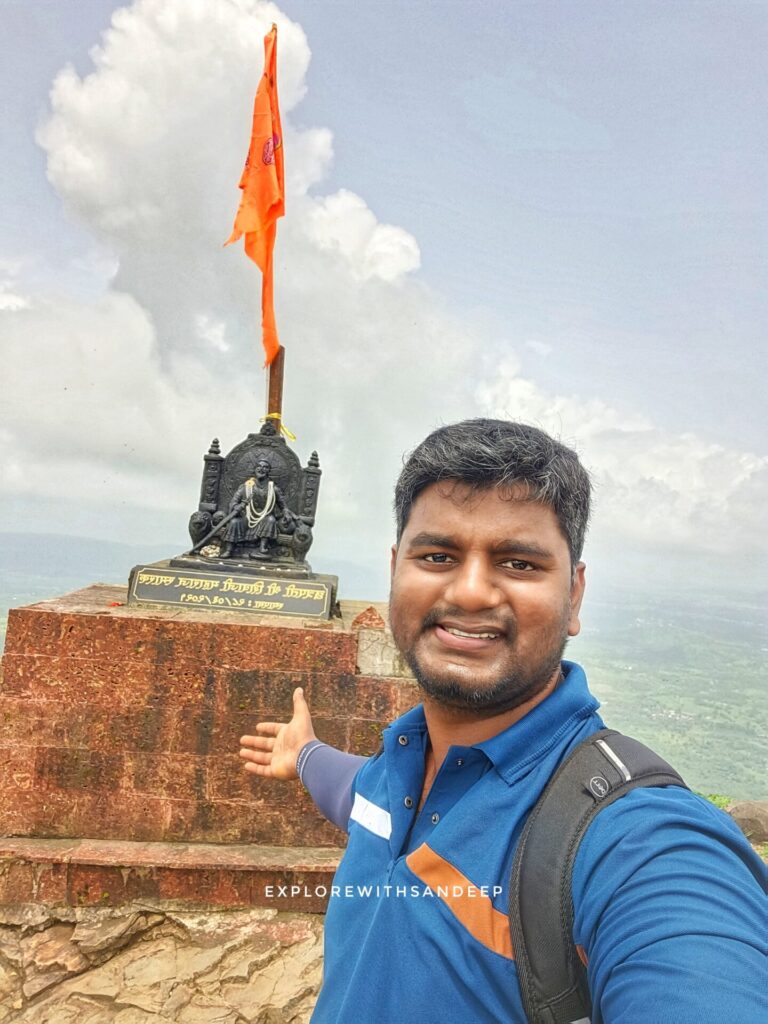
Trekking to Kalavantin Durg was far more than just a day trip – it was an epic adventure that challenged every aspect of our physical and mental capabilities (and taught me that my fitness app had been lying to me about my stamina! 📱😅). From walking through monsoon-fresh forests 🌧️🌿 and cooling off at natural waterfalls 💦 to climbing ancient rock-carved stairs 🪜 and exploring hidden caves 🕳️, the experience offered everything an adventure seeker could desire (plus a few things we didn’t know we wanted, like existential crisis at 2000 feet! 😰🏔️).
The trek tested our endurance, courage, and determination while rewarding us with some of the most spectacular views in Maharashtra 💪👀. Standing at the summit, surrounded by the majesty of the Sahyadri mountains with the idol of Chhatrapati Shivaji Maharaj as our witness 👑⛰️, we felt a profound connection to both nature and history (and also to our chiropractor, because our backs were killing us 😂🤕).
If you crave genuine thrills, pristine natural beauty, and a challenge that will test your limits, Kalavantin Durg is calling your name 📞🏔️. Just remember to respect the mountain, prepare thoroughly, and always prioritize safety over adventure (because being a living legend is better than being a cautionary tale! 🦺😄).
Difficulty Rating: ⭐⭐⭐⭐ (Expert Level Only, aka “Have you written your will?” level 📝💀)
Are you ready to accept this incredible challenge? Pack your gear, lace up those trekking boots, and prepare to shout with pride (and possibly terror):
“Chhatrapati Shivaji Maharaj ki Jai!”
If you found this trek guide helpful, please share it with fellow adventure enthusiasts 📤😊. Stay tuned for more thrilling trek stories from the magnificent Sahyadri mountains (assuming I survive my next adventure! 😅🏔️)!
Kalavantin Durg Trek: Frequently Asked Questions (FAQs)
1. How difficult is the Kalavantin Durg trek?
The trek is moderate to difficult. The ascent is steep, especially the final rock-cut steps. The descent can be scarier than the climb. It’s recommended for those with a decent fitness level and no fear of heights.
2. Is Kalavantin Durg safe?
The trek is safe if you are careful. The trail is exposed at certain points, especially near the summit. Avoid trekking during monsoons or strong winds. Use proper footwear and avoid risky selfies.
3. Do I need a guide?
A guide is not mandatory, but if you’re unfamiliar with the trail or going during early morning or late evening, it’s better to have a local guide for safety and directions.
4. How long does the trek take?
The full trek takes 3 to 4 hours (both ways) depending on your speed and fitness level:
Base to Prabalmachi: ~1.5 hours
Prabalmachi to Kalavantin Top: ~1 hour
Descent: ~1.5 hours
5. When is the best time to visit Kalavantin Durg?
The best time is from October to February when the weather is pleasant and dry. Avoid monsoon season (June–September) due to slippery rocks and increased risk.
6. Where does the trek start from?
The trek starts from Thakurwadi village, which is accessible from Panvel. From there, you hike to Prabalmachi, the base village for Kalavantin and Prabalgad forts.
7. Is there any place to stay overnight?
Yes, camping is possible near Prabalmachi village, which lies between Prabalgad and Kalavantin Durg. Many trekkers prefer to do night treks and camp there.
8. What should I carry for the trek?
Here’s a quick list:
– Good trekking shoes
– Water (at least 2L)
– Cap, sunglasses, sunscreen
– Snacks/dry fruits
– Light jacket (if staying overnight)
– Basic first aid
– Flashlight (if trekking early/late)
9. Is it child-friendly?
Not recommended for small children due to the steep and risky final climb. Teens above 14 with experience and guidance may be able to manage.
10. Where is Kalavantin Durg located?
Kalavantin Durg is located near Panvel, in the Raigad district of Maharashtra, close to the Prabalmachi village.
11. What is the best time to visit Kalavantin Durg?
The best time to visit is October to February for clear skies and pleasant weather. If you’re looking for lush greenery and foggy views, June to September (monsoon) is also popular – but slippery paths make it more risky.
12. Is there any entry fee for Kalavantin Durg?
There is no official entry fee for the trek. However, you may need to pay:
– ₹30 for parking
– ₹30 for the rock climbing section near the final climb (managed by locals)

